Vous pouvez lire le billet sur le blog La Minute pour plus d'informations sur les RSS !
 Géomatique anglophone
Géomatique anglophone
-
sur gvSIG Team: Premio Nacional de Ciencias Geográficas… agradecimientos
Publié: 29 May 2024, 9:03am CEST
Estamos sobrepasados emocionalmente por el número de agradecimientos y apoyos recibidos al darse a conocer que la Asociación gvSIG ha recibido el primer Premio Nacional de Ciencias Geográficas que se otorga en España.

Sin duda este premio está compuesto de muchos pedacitos, de muchas organizaciones y personas que han ido sumando a este proyecto. Este post quiere agradecer a algunas de estas entidades que han dado su apoyo a la candidatura de la Asociación gvSIG en una lista que tiende a infinito. ¡Gracias!
Universidad Autónoma del Estado de México (UAEM), Universidad Nacional de Misiones de Argentina (UNaM), Universidad Católica de la Santísima Concepción de Chile (UCSC), Instituto Tecnológico de Informática (ITI), Gaia-X, Centro de Investigação em Ciências Geo-Espaciais (CICGE) – Faculdade de Ciências da Universidade do Porto, North Carolina State University (NC State University), Universidad Politécnica de Madrid (UPM), Massachusetts Institute of Technology (MIT), Universidad Politécnica de Cartagena (UPCT), University of New Hampshire, Universidad Central “Marta Abreu” de Las Villas – Cuba, Asamblea de Cooperación por la Paz (ACPP), Instituto de Geografía de la Universidad de Buenos Aires, Centro de Investigaciones en Geografía Ambiental de la Universidad Nacional Autonóma de México (UNAM), Colegio Profesional de Delineantes y Diseñadores Te?nicos de Andalucía (CODTA), European Commission open source programme office, Universitat Jaume I de Castellón, Infraestructura de Datos Espaciales del Uruguay, Institute of Applied Physics (IFAC) – National Research Council (CNR) de Italia, Ordnance Survey (United Kingdom National Mapping Agency), Universidad Nacional de General Sarmiento de Argentina, Open Source Geospatial Foundation (OSGeo), Diputación de Albacete, Laberit Sistemas, DISID Corporation, SCOLAB Software Colaborativo, Ayuntamiento de Talavera de la Reina, Universidad Don Bosco de El Salvador, Universitat de València, Green Urban Data, eGeoMapping, Revista Internacional de Geomática y Ciencias de la Tierra MAPPING, Grupo MERCATOR: Tecnologías de la GeoInformación y Agentes inteligentes, Universidad Nacional de Moreno, Instituto Federal do Pará de Brasil, Observatorio de Estudios sobre Convivencia y Seguridad Ciudadana – Gobierno de la provincia de Córdoba de Argentina, Universidad de Santiago de Chile, Universidad de La Laguna, Universidade da Coruña, Universidad de Coimbra – Portugal, Instituto Panamericano de Geografía e Historia (IPGH), Mundialis GmbH & Co, Kalios Geospatial Technologies – India, Ayuntamiento de Castellón, Consorcio Provincial de Bomberos de Valencia (CPBV), Smart to People Solutions, Comunidade Intermunicipal do Alto Tâmega e Barroso, Tresca Ingeniería, Avansig, Intendencia de Montevideo – Uruguay, Ayuntamiento de Valencia, Instituto Nacional de Estadística y Geografía de México (INEGI), Conselleria de Medio Ambiente, Agua, Infraestructuras y Territorio de la Generalitat Valenciana, Washington State Department of Transportation, Pavapark Movilidad, Innovación, Cooperación, Cartografía y Territorio (iCarto), Politecnico Milano, Ayuntamiento de Cartagena, Istanbul University, Ayuntamiento de Albacete, Universitat Politècnica de Catalunya (UPC), Universidad de las Azores, Fundación Forjando Futuros, Universidad de Costa Rica, Ion Creanga State Pedagogical University – República de Moldavia, Sociedad de Ingenieros Geodestas, Geomáticos y Agrimensores de Venezuela (SIGGMA), Asociación Española de Geómetras Expertos (GEX), Ayuntamiento de Úbeda, Empresa Brasileira de Pesquisa Agropecuária (EMBRAPA), GIZ cono Sur, Universidad de Playa Ancha – Chile, LandNetwork GmbH, Universitat Politècnica de València, Ajuntament d’Onda, ASECRIM, Laboratorio Internacional de Tecnología e Investigación Espacial (ISTAR) – México, Gobierno de la República Dominicana, Universidad Regional Amazónica Ikiam, Comunidad gvSIG Uruguay, Confederación Empresarial de la Comunitat Valenciana (CEV), Ayuntamiento de l’Eliana, IdeasG – Perú, Hímaco (História, Mapas e Computadores) – Universidade Federal de São Paulo (UFSP), Instituto de Geografía UNAM, Instituto Valenciano de Competitividad Empresarial (IVACE), Mancomunitat del Pla de Mallorca, DALEPH, Alkante – Francia, Geospatial Enabling Technologies, Universidad Filadelfia de México, Geomática del Golfo, Université Rennes 2 – Francia, Universitat Oberta de Catalunya, Infraestructura de Datos Espaciales de Santa Fe (IDESF), Asociación para la prevención de incendios forestales (PREVIFOR), Universidad Internacional de Valencia (VIU), Universidad de Castilla – La Mancha (UCLM), Map4Business, GAUSSGEO Geotecnologia e Engenharia LTDA, Intendencia Departamental de Durazno, NISR, VinfoVAL, Geodireito – Planejamento e Regulação Ltda, Governo do Estado Tocantins – Brasil, Ajuntament d’Alzira, Universidad de Belgrano, Universidad de las Fuerzas Armadas ESPE – Ecuador, MundoGEO, Ajuntament de Torrent, Indromeda, Corredor Mediterráneo del Gobierno de España (MITMA-Adif), Programa Iberoamericano de Ciencia y Tecnología para el Desarrollo (CYTED), Instituto Tecnológico de Canarias, Alumni UPV, Universidad de La Rioja, Diputació de Barcelona, Geoscan Consultoría, Universidad Autonóma de Sinaloa,…
-
sur The Loss of the Great American Grasslands
Publié: 29 May 2024, 8:07am CEST par Keir Clarke
The Cornell Lab of Ornithology and the Act for Grasslands. have teamed up to map the loss of grasslands in the United States. Over 2 million acres of American grasslands are lost on average every year. The result of which has a devastating effect on American wildlife. Using historical satellite records Map for Grasslands has tracked grassland loss in the USA over the last 30 years. By
-
sur OPENGIS.ch: The PostgreSQL Connection Service File and Why We Love It
Publié: 28 May 2024, 3:18pm CEST
The PostgreSQL Connection Service File
What is the Connection Service File?pg_service.confis nothing new. It has existed for quite some time and maybe you have already used it sometimes too. But not only the new QGIS plugin PG service parser is a reason to write about our love for this file, as well we generally think it’s time to show you how it can be used for really cool things.The Connection Service File allows you to save connection settings for each so-called “service” locally.
So when you have a database called
gison a local PostgreSQL with port5432and username/password isdocker/dockeryou can store this as a service calledmy-local-gis.
[my-local-gis]# Local GIS Database for Testing purposeshost=localhost port=5432 dbname=gis user=docker password=docker
This Connection Service File is called
pg_service.confand is by client applications (such as psql or QGIS) generally found directly in the user directory. In Windows it is then found in the user’s application directorypostgresql.pg_service.conf. And in Linux it is by default located directly in the user’s directory~/.pg_service.conf.But it doesn’t necessarily have to be there. The file can be anywhere on the system (or on a network drive) as long as you set the environment variable
PGSERVICEFILEaccordingly:export PGSERVICEFILE=/home/dave/connectionfiles/pg_service.confOnce you have done this, the client applications will search there first – and find it.
If the above are not set, there is also another environment variable
PGSYSCONFDIRwhich is a folder which is searched for the filepg_service.conf.Once you have this, the service name can be used in the client application. That means in psql it would look like this:
~$ psql service=my-local-gis psql (14.11 (Ubuntu 14.11-0ubuntu0.22.04.1), server 14.5 (Debian 14.5-1.pgdg110+1)) SSL connection (protocol: TLSv1.3, cipher: TLS_AES_256_GCM_SHA384, bits: 256, compression: off) Type "help" for help. gis=#And in QGIS like this:

If you then add a layer in QGIS, only the name of the service is written in the project file. Neither the connection parameters nor username/password are saved. In addition to the security aspect, this has various advantages, more on this below.
But you don’t have to pass all of these parameters to a service. If you only pass parts of them (e.g. without the database), then you have to pass them when the connection is called:
$psql "service=my-local-gis dbname=gis" psql (14.11 (Ubuntu 14.11-0ubuntu0.22.04.1), server 14.5 (Debian 14.5-1.pgdg110+1)) SSL connection (protocol: TLSv1.3, cipher: TLS_AES_256_GCM_SHA384, bits: 256, compression: off) Type "help" for help. gis=#You can also override parameters. If you have a database
gisconfigured in the service, but you want to connect the database web, you can specify the service and explicit the database:$psql "service=my-local-gis dbname=web" psql (14.11 (Ubuntu 14.11-0ubuntu0.22.04.1), server 14.5 (Debian 14.5-1.pgdg110+1)) SSL connection (protocol: TLSv1.3, cipher: TLS_AES_256_GCM_SHA384, bits: 256, compression: off) Type "help" for help. web=#Of course the same applies to QGIS.
And regarding the environment variables mentioned, you can also set a standard service.
export PGSERVICE=my-local-gisParticularly pleasant in daily work with always the same database.
And why is it particularly cool?$ psql psql (14.11 (Ubuntu 14.11-0ubuntu0.22.04.1), server 14.5 (Debian 14.5-1.pgdg110+1)) SSL connection (protocol: TLSv1.3, cipher: TLS_AES_256_GCM_SHA384, bits: 256, compression: off) Type "help" for help. gis=#There are several reasons why such a file is useful:
- Security: You don’t have to save the connection parameters anywhere in the client files (e.g. QGIS project files). Keep in mind that they are still plain text in the service file.
- Decoupling: You can change the connection parameters without having to change the settings in client files (e.g. QGIS project files).
- Multi-User: You can save the file on a network drive. As long as the environment variable of the local systems points to this file, all users can access the database with the same parameters.
- Diversity: You can use the same project file to access different databases with the same structure if only the name of the service remains the same.
For the last reason, here are three use cases.
Support-CaseSomeone reports a problem in QGIS on a specific case with their database. Since the problem cannot be reproduced, they send us a DB dump of a schema and a QGIS project file. The layers in the QGIS project file are linked to a service. Now we can restore the dump on our local database and access it with our own, but same named, service. The problem can be reproduced.
INTERLISWith INTERLIS the structure of a database schema is precisely specified. If e.g. the canton has built the physical database for it and configured a supernice QGIS project, they can provide the project file to a company without also providing the database structure. The company can build the schema based on the INTERLIS model on its own PostgreSQL database and access it using its own service with the same name.
Test/Prod SwitchingYou can access a test and a production database with the same QGIS project if you have set the environment variable for the connection service file accordingly per QGIS profile.
You create two connection service files.
The one to the test database
/home/dave/connectionfiles/test/pg_service.conf:[my-local-gis] host=localhost port=54322 dbname=gis-testAnd the one for the production database
/home/dave/connectionfiles/prod/pg_service.conf:[my-local-gis] host=localhost port=54322 dbname=gis-productiveIn QGIS you create two profiles “Test” and “Prod”:
And you set the environment variable for each profile
PGSERVICEFILEwhich should be used (in the menu Settings > Options… and there under System scroll down to Environmentor
If you now use the service
The authentication configurationmy-local-gisin a QGIS layer, it connects the databaseprodin the “Prod” profile and the databasetestin the “Test” profile.Let’s have a look at the authentication. If you have the connection service file on a network drive and make it available to several users, you may not want everyone to access it with the same login. Or you generally don’t want any user information in this file. This can be elegantly combined with the authentication configuration in QGIS.
If you want to make a QGIS project file available to multiple users, you create the layers with a service. This service contains all connection parameters except the login information.
This login information is transferred using QGIS authentication.
You also configure this authentication per QGIS profile we mentioned above. This is done via Menu Settings > Options… and there under Authentication:
(or directly where you create the PostgreSQL connection)
If you add such a layer, the service and the ID of the authentication configuration are saved in the QGIS project file. This is in this case
mylogin. Of course this name must be communicated to the other users so that they can also set the ID for their login tomylogin.Of course, you can use multiple authentication configurations per profile.
QGIS PluginAnd yes, there is now a great plugin to configure these services directly in QGIS. This means you no longer have to deal with text-based INI files. It’s called PG service parser:
It finds the connection service file according to the mentioned environment variables
PGSERVICEFILEorPGSYSCONFDIRor at its default location.As well it’s super easy to create new services by duplicating existing ones.
And for the Devs
And what would a blog post be without some geek food? The back end of this plugin is published on PYPI and can be easily installed with
pip install pgserviceparserand then be used in Python.For example to list all the service names.
>>> import pgserviceparser >>> pgserviceparser.service_names() ['my-local-gis', 'another-local-gis', 'opengisch-demo-pg']Optionally you can pass a config file path. Otherwise it gets it by the mentioned mechanism.
Or to receive the configuration from the given service name as a dict.
>>> pgserviceparser.service_config('my-local-gis') {'host': 'localhost', 'port': '54322', 'dbname': 'gis', 'user': 'docker', 'password': 'docker'}There are some more functions. Check them out here on GitHub or in the documentation.
Well thenWe hope you share our enthusiasm for this beautiful file – at least after reading this blog post. And if not – feel free to tell us why you don’t in the comments

-
sur GeoSolutions: GeoSolutions presenting at FOSS4G 2024 Europe in Tartu (Estonia)
Publié: 28 May 2024, 2:53pm CEST
You must be logged into the site to view this content.
-
sur gvSIG Team: Transportes concede el primer Premio Nacional de Ciencias Geográficas a la asociación gvSIG
Publié: 28 May 2024, 2:44pm CEST

Reproducimos la nota de prensa oficial:
El Ministerio de Transportes y Movilidad Sostenible ha galardonado a la asociación gvSIG con el primer Premio Nacional de Ciencias Geográficas, que recompensa a personas o entidades que hayan contribuido de forma especial o mediante su actuación singular o trayectoria profesional al campo de las Ciencias Geográficas. La resolución de concesión se publicará próximamente en el Boletín Oficial del Estado (BOE).
Este galardón, con una dotación económica de 20.000 euros, es instruido por el Centro Nacional de Información Geográfica a iniciativa del Consejo Superior Geográfico, órgano de dirección del Sistema Cartográfico Nacional, y trata de poner en valor la aportación, innovación e impacto de los avances conseguidos en la producción, actualización y uso cotidiano de la información geográfica, sus infraestructuras y los productos y servicios derivados de ella.
La Asociación gvSIG es una entidad española sin ánimo de lucro, dedicada a la investigación, innovación y desarrollo de tecnologías de software libre y código abierto relacionadas con las ciencias geográficas. Basándose en valores como la colaboración, la solidaridad y el conocimiento compartido, se ha convertido en un referente internacional, siendo su catálogo de soluciones tecnológicas para la gestión de información geográfica utilizado en la práctica totalidad del planeta.
La Asociación gvSIG ha contribuido notablemente a la comunidad de código abierto y a las tecnologías geográficas, así como al impulso de estándares, desarrollando una serie de soluciones de amplio uso que han permitido constituir un nuevo modelo de negocio exitoso que permite a pequeñas y medianas empresas españolas ofrecer servicios y proyectos en diversos países.
De este modo, ha realizado proyectos en más de treinta países, fomentando la internacionalización de empresas españolas. Entre los ejemplos de grandes proyectos se encuentran la Infraestructura de Datos Espaciales de Uruguay, la IDE del Estado de Tocantins en Brasil, la aplicación para identificación de riesgos en los desplazamientos de los Cascos Azules en Malí o la IDE de Repsol para la gestión de proyectos de energías renovables, el Atlas de Expansión Urbana desarrollado para ONU-Habitat o el actual desarrollo del sistema de gestión de Catastro Multipropósito de la República Dominicana.
Aportación a las Ciencias GeográficasEl Premio Nacional de Ciencias Geográficas reconoce así a esta asociación su aportación e innovación, individual y colectiva, en el campo de las ciencias e ingeniería geográficas, la geomática, la cartografía y la información geoespacial, y su trascendencia, e impacto en el conjunto de las administraciones públicas y de la sociedad en general.
El jurado que ha informado el otorgamiento del galardón ha adoptado su decisión por unanimidad, tras valorar los méritos aportados por un total de catorce candidaturas que elevaron las deliberaciones a un nivel de gran excelencia. Ha estado presidido por el subsecretario de Transportes y Movilidad Sostenible y presidente del Consejo Superior Geográfico, actuando como vicepresidente el director general del IGN y presidente del CNIG, y contando como miembros a los representantes de los órganos de gobierno del Consejo Superior Geográfico y de colegios profesionales en el ámbito de las ciencias geográficas.
-
sur Mappery: Maps rock!
Publié: 28 May 2024, 11:00am CEST
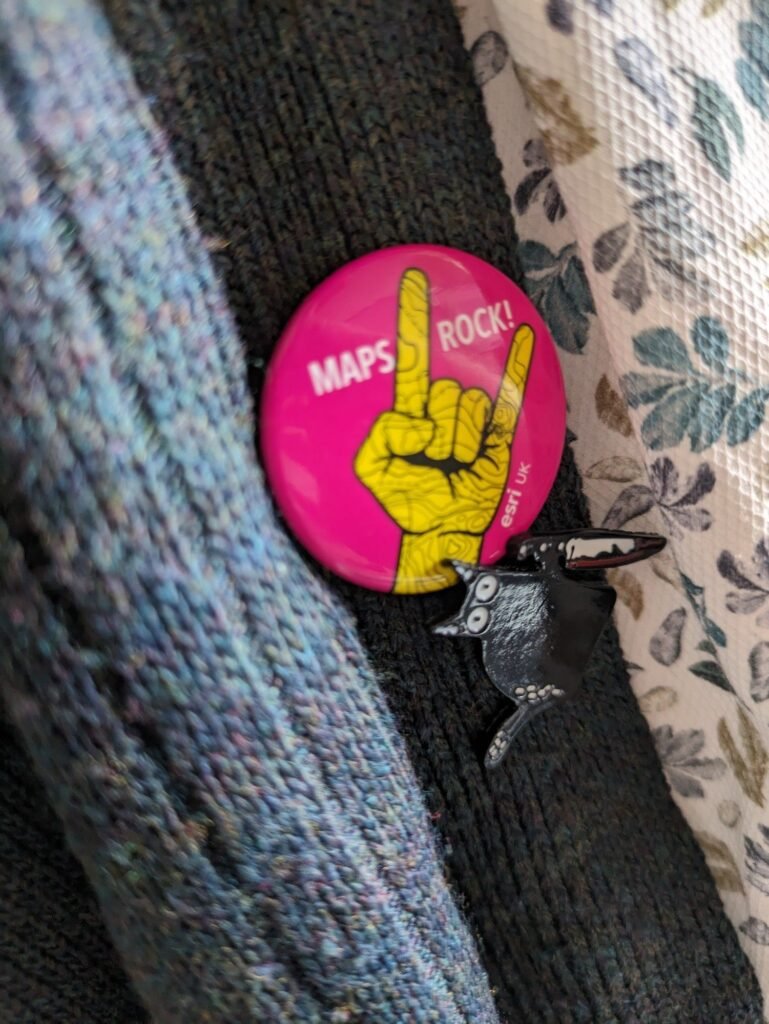
In case there would be any doubts, Maps Rock! Thanks, Dean, for sharing this badge.
MapsintheWild Maps rock!
-
sur The Death of Japantown
Publié: 28 May 2024, 10:56am CEST par Keir Clarke
I'm a little late to this one but last month the San Francisco Chronicle published a superb story map documenting the effect of America's internment of Japanese American citizens in World War II on San Francisco's Japantown District.Following the Japanese attack on Pearl Harbor in 1941, President Franklin D. Roosevelt signed Executive Order 9066. This order led to the forced removal and
-
sur OPENGIS.ch: The PostgreSQL Connection Service File and Why We Love It
Publié: 28 May 2024, 6:55am CEST
The PostgreSQL Connection Service File
What is the Connection Service File?pg_service.confis nothing new. It has existed for quite some time and maybe you have already used it sometimes too. But not only the new QGIS plugin PG service parser is a reason to write about our love for this file, as well we generally think it’s time to show you how it can be used for really cool things.The Connection Service File allows you to save connection settings for each so-called “service” locally.
So when you have a database called
gison a local PostgreSQL with port5432and username/password isdocker/dockeryou can store this as a service calledmy-local-gis.# Local GIS Database for Testing purposes [my-local-gis] host=localhost port=5432 dbname=gis user=docker password=dockerThis Connection Service File is called
pg_service.confand is by client applications (such as psql or QGIS) generally found directly in the user directory. In Windows it is then found in the user’s application directorypostgresql.pg_service.conf. And in Linux it is by default located directly in the user’s directory~/.pg_service.conf.But it doesn’t necessarily have to be there. The file can be anywhere on the system (or on a network drive) as long as you set the environment variable
PGSERVICEFILEaccordingly:export PGSERVICEFILE=/home/dave/connectionfiles/pg_service.confOnce you have done this, the client applications will search there first – and find it.
If the above are not set, there is also another environment variable
PGSYSCONFDIRwhich is a folder which is searched for the filepg_service.conf.Once you have this, the service name can be used in the client application. That means in psql it would look like this:
~$ psql service=my-local-gis psql (14.11 (Ubuntu 14.11-0ubuntu0.22.04.1), server 14.5 (Debian 14.5-1.pgdg110+1)) SSL connection (protocol: TLSv1.3, cipher: TLS_AES_256_GCM_SHA384, bits: 256, compression: off) Type "help" for help. gis=#And in QGIS like this:

If you then add a layer in QGIS, only the name of the service is written in the project file. Neither the connection parameters nor username/password are saved. In addition to the security aspect, this has various advantages, more on this below.
But you don’t have to pass all of these parameters to a service. If you only pass parts of them (e.g. without the database), then you have to pass them when the connection is called:
$psql "service=my-local-gis dbname=gis" psql (14.11 (Ubuntu 14.11-0ubuntu0.22.04.1), server 14.5 (Debian 14.5-1.pgdg110+1)) SSL connection (protocol: TLSv1.3, cipher: TLS_AES_256_GCM_SHA384, bits: 256, compression: off) Type "help" for help. gis=#You can also override parameters. If you have a database
gisconfigured in the service, but you want to connect the database web, you can specify the service and explicit the database:$psql "service=my-local-gis dbname=web" psql (14.11 (Ubuntu 14.11-0ubuntu0.22.04.1), server 14.5 (Debian 14.5-1.pgdg110+1)) SSL connection (protocol: TLSv1.3, cipher: TLS_AES_256_GCM_SHA384, bits: 256, compression: off) Type "help" for help. web=#Of course the same applies to QGIS.
And regarding the environment variables mentioned, you can also set a standard service.
export PGSERVICE=my-local-gisParticularly pleasant in daily work with always the same database.
And why is it particularly cool?$ psql psql (14.11 (Ubuntu 14.11-0ubuntu0.22.04.1), server 14.5 (Debian 14.5-1.pgdg110+1)) SSL connection (protocol: TLSv1.3, cipher: TLS_AES_256_GCM_SHA384, bits: 256, compression: off) Type "help" for help. gis=#There are several reasons why such a file is useful:
- Security: You don’t have to save the connection parameters anywhere in the client files (e.g. QGIS project files). Keep in mind that they are still plain text in the service file.
- Decoupling: You can change the connection parameters without having to change the settings in client files (e.g. QGIS project files).
- Multi-User: You can save the file on a network drive. As long as the environment variable of the local systems points to this file, all users can access the database with the same parameters.
- Diversity: You can use the same project file to access different databases with the same structure if only the name of the service remains the same.
For the last reason, here are three use cases.
Support-CaseSomeone reports a problem in QGIS on a specific case with their database. Since the problem cannot be reproduced, they send us a DB dump of a schema and a QGIS project file. The layers in the QGIS project file are linked to a service. Now we can restore the dump on our local database and access it with our own, but same named, service. The problem can be reproduced.
INTERLISWith INTERLIS the structure of a database schema is precisely specified. If e.g. the canton has built the physical database for it and configured a supernice QGIS project, they can provide the project file to a company without also providing the database structure. The company can build the schema based on the INTERLIS model on its own PostgreSQL database and access it using its own service with the same name.
Test/Prod SwitchingYou can access a test and a production database with the same QGIS project if you have set the environment variable for the connection service file accordingly per QGIS profile.
You create two connection service files.
The one to the test database
/home/dave/connectionfiles/test/pg_service.conf:[my-local-gis] host=localhost port=54322 dbname=gis-testAnd the one for the production database
/home/dave/connectionfiles/prod/pg_service.conf:[my-local-gis] host=localhost port=54322 dbname=gis-productiveIn QGIS you create two profiles “Test” and “Prod”:
And you set the environment variable for each profile
PGSERVICEFILEwhich should be used (in the menu Settings > Options… and there under System scroll down to Environmentor
If you now use the service
The authentication configurationmy-local-gisin a QGIS layer, it connects the databaseprodin the “Prod” profile and the databasetestin the “Test” profile.Let’s have a look at the authentication. If you have the connection service file on a network drive and make it available to several users, you may not want everyone to access it with the same login. Or you generally don’t want any user information in this file. This can be elegantly combined with the authentication configuration in QGIS.
If you want to make a QGIS project file available to multiple users, you create the layers with a service. This service contains all connection parameters except the login information.
This login information is transferred using QGIS authentication.
You also configure this authentication per QGIS profile we mentioned above. This is done via Menu Settings > Options… and there under Authentication:
(or directly where you create the PostgreSQL connection)
If you add such a layer, the service and the ID of the authentication configuration are saved in the QGIS project file. This is in this case
mylogin. Of course this name must be communicated to the other users so that they can also set the ID for their login tomylogin.Of course, you can use multiple authentication configurations per profile.
QGIS PluginAnd yes, there is now a great plugin to configure these services directly in QGIS. This means you no longer have to deal with text-based INI files. It’s called PG service parser:
It finds the connection service file according to the mentioned environment variables
PGSERVICEFILEorPGSYSCONFDIRor at its default location.As well it’s super easy to create new services by duplicating existing ones.
And for the Devs
And what would a blog post be without some geek food? The back end of this plugin is published on PYPI and can be easily installed with
pip install pgserviceparserand then be used in Python.For example to list all the service names.
>>> import pgserviceparser >>> pgserviceparser.service_names() ['my-local-gis', 'another-local-gis', 'opengisch-demo-pg']Optionally you can pass a config file path. Otherwise it gets it by the mentioned mechanism.
Or to receive the configuration from the given service name as a dict.
>>> pgserviceparser.service_config('my-local-gis') {'host': 'localhost', 'port': '54322', 'dbname': 'gis', 'user': 'docker', 'password': 'docker'}There are some more functions. Check them out here on GitHub or in the documentation.
Well thenWe hope you share our enthusiasm for this beautiful file – at least after reading this blog post. And if not – feel free to tell us why you don’t in the comments

-
sur Martin Davis: RelateNG Performance
Publié: 28 May 2024, 1:14am CEST
A previous post introduced a new algorithm in the JTS Topology Suite called RelateNG. It computes topological relationships between geometries using the Dimensionally-Extended 9 Intersection Model (DE-9IM) model.
This algorithm is fundamental to a large proportion of spatial queries executed in numerous geospatial environments. It would not be surprising to learn that the Relate algorithm is executed billions of times per day across the world's data centres. Given this, performance is a critical metric.
The original JTS RelateOp algorithm was hamstrung by its design, which required computing a full topology graph for each relationship evaluation. The subsequent development of PreparedGeometry provided a significant performance boost for common spatial predicates such as intersects and covers. A useful side-effect is that it is less susceptible to geometric robustness problems. However, it has some drawbacks:
- it only implements a small set of predicates
- the design does not easily extend to more complex predicates
- it does not support GeometryCollection inputs
- it is a completely separate codebase to the general-purpose RelateOp, which increases maintenance effort and increases the risk of bugs and behaviour discrepancies
The test data metrics are:- Query MultiPolygon: 461 polygons, 22,675 vertices
- Target Points: 10,000 points
 Timings
Timings
Op Intersects Intersects Prep Relate 61.7 s 21 ms RelateNG 0.1 s 19 ms
The result clearly shows the enormous improvement in the stateless case, since RelateNG does not build topology on the input polygon. The results are very similar in the prepared case. This is as expected, since both codebases run a simple Point-in-Polygon test using a cached spatial index.Line / LineThis test uses a dataset of major rivers of the continental United States. A single river mainstem is queried against a subset of river branches using the intersects and touches relationships, in stateless and prepared modes.
The test data metrics are:- Query Line: 6,975 vertices
- Target Lines: 407 lines with 47,328 vertices
 Timings (per 100 executions of the operation)
Timings (per 100 executions of the operation)
This shows the much better performance of RelateNG. RelateNG can evaluate touches in prepared mode, but the performance is similar to stateless mode, since currently indexes are not cached for Line/Line cases. This could be improved in a future release.Polygon / PolygonThis test uses data from two polygonal datasets:Op Intersects Intersects Prep Touches Touches Prep Relate 38.2 s 133 ms 36 s N/A RelateNG 1.18 s 142 ms 2.05 s 2.03 s - The Britsh Columbia Bedrock Geology polygonal coverage
- The GADM Level 2 boundaries for Canada
The test data metrics are:- GADM unit: 4,017 vertices
- Bedrock polygons: 4,318 polygon with 337,650 vertices
 Timings (per 100 executions of the operation)
Timings (per 100 executions of the operation)
Polygon / Polygon - Custom Relate PatternThe tests shows the ability of RelateNG to efficiently evaluate arbitrary Relate Intersection Matrix patterns. In this case, the pattern used is F***0****, which corresponds to a relationship which could be called "point-touches": two geometries have boundaries which intersect in only one (or more) points (dimension 0), but whose interiors do not intersect.Op Intersects Intersects Prep Covers Covers Prep Relate 61.7 s 534 ms 54.9 s 842 ms RelateNG 5.8 s 595 ms 6.4 s 943 ms
This test uses data from The GADM Level 1 boundaries for Canada. This has the advantage that Canada contains a rare example of 4 boundaries meeting at a single point (the jurisdictions of Saskatchewan, Manitoba, Northwest Territories, and Nunavut).
The test data metrics are:- GADM Canada Level 1: 13 polygons, 4,005,926 vertices
 Timings
Timings
Op F***0**** F***0**** Prep Relate 504 s N/A RelateNG 9.8 s 6.6 s
As expected, for this test RelateNG is far more performant than Relate. This is due to its ability to analyze Intersection Matrix patterns and perform only topology tests that are necessary, as well as not building a full topological structure of the inputs. The test shows the effect of caching spatial indexes in prepared mode, although stateless mode is very efficient as well. Analysis of ResultsClearly RelateNG is far more performant than Relate when running in non-prepared mode. The PreparedGeometry implementation is slightly faster (which confirms the efficiency of its original design), but not by very much. The difference may be a consequence of the general-purpose and thus more complex code and data structures in RelateNG. Closing this gap may be an area for future research.One thing is certain: the RelateNG algorithm design provides much more scope for adding case-specific optimizations. If you have a significant use case which could be improved by further targeted optimization improvements, let me know in the comments!It will be interesting to re-evaluate these tests once RelateNG is ported to GEOS. Sometimes (but not always) a C++ implementation can be significantly faster than Java, due to more opportunities for code and compiler optimization. -
sur GRASS GIS: Google Summer of Code 2024
Publié: 27 May 2024, 9:12pm CEST
Three GSoC students will be contributing to GRASS GIS this summer! We are thrilled to announce that the GRASS GIS project has three Google Summer of Code (GSoC) students this year! They will be working together with their mentors on enhancing different GRASS tools and capabilities. Let’s go briefly through some details on each project and their forseen broader impacts. Improve GRASS user experience in Jupyter Notebook Student: Riya Saxena Mentors: Anna Petrasova, Corey White The python package grass. -
sur gvSIG Team: aanguix
Publié: 27 May 2024, 6:05pm CEST
-
sur Fernando Quadro: O que é o DATUM?
Publié: 27 May 2024, 2:00pm CEST
O DATUM é um termo utilizado na área da geodésica que se refere a um sistema de referência utilizado para determinar as coordenadas geográficas na superfície da Terra. Ele é fundamental para a realização de medições precisas e confiáveis em projetos de cartografia e geoprocessamento.
 É baseado em alguns princípios fundamentais:
É baseado em alguns princípios fundamentais: Considera a Terra como um elipsoide, ou seja, um corpo sólido de formato semelhante a uma esfera achatada nos polos e alongada no equador.
Considera a Terra como um elipsoide, ou seja, um corpo sólido de formato semelhante a uma esfera achatada nos polos e alongada no equador.
 Leva em conta a gravidade terrestre, rotação da Terra e a distribuição de massa em seu interior.
Leva em conta a gravidade terrestre, rotação da Terra e a distribuição de massa em seu interior.A diferença entre um datum e outro é baseada em modelos matemáticos distintos da forma e dimensões da Terra e do fator adicional da projeção, seja por razões históricas, seja para garantir uma representação gráfica mais proporcionada; tomando como exemplo o Japão, onde usam um ponto da projeção que não está no centro da Terra, mas em algum lugar sob o Japão, isto permite uma menor distorção numa projeção de uma esfera sobre plano quando o Japão é representado, mas no entanto o uso dessa projeção para os Estados Unidos ou para o Brasil resultaria em um mapa muito estranho.
 O uso do DATUM possibilita diversos benefícios, veja:
O uso do DATUM possibilita diversos benefícios, veja: Precisão nas medições
Precisão nas medições
 Padronização global
Padronização global
 Compatibilidade com Sistemas de Posicionamento Global (GPS)
Compatibilidade com Sistemas de Posicionamento Global (GPS)
 Melhoria na precisão dos mapas
Melhoria na precisão dos mapasO DATUM apresenta diversos benefícios, no entanto, seu uso também apresenta desafios, como a necessidade de atualização constante e a complexidade dos cálculos.
O futuro do DATUM está ligado ao avanço da tecnologia, o que permitirá realizar medições ainda mais precisas e eficientes.
Gostou desse post? Conte nos comentários

-
sur Mappery: Globes at the Whitechapel Gallery
Publié: 27 May 2024, 11:00am CEST
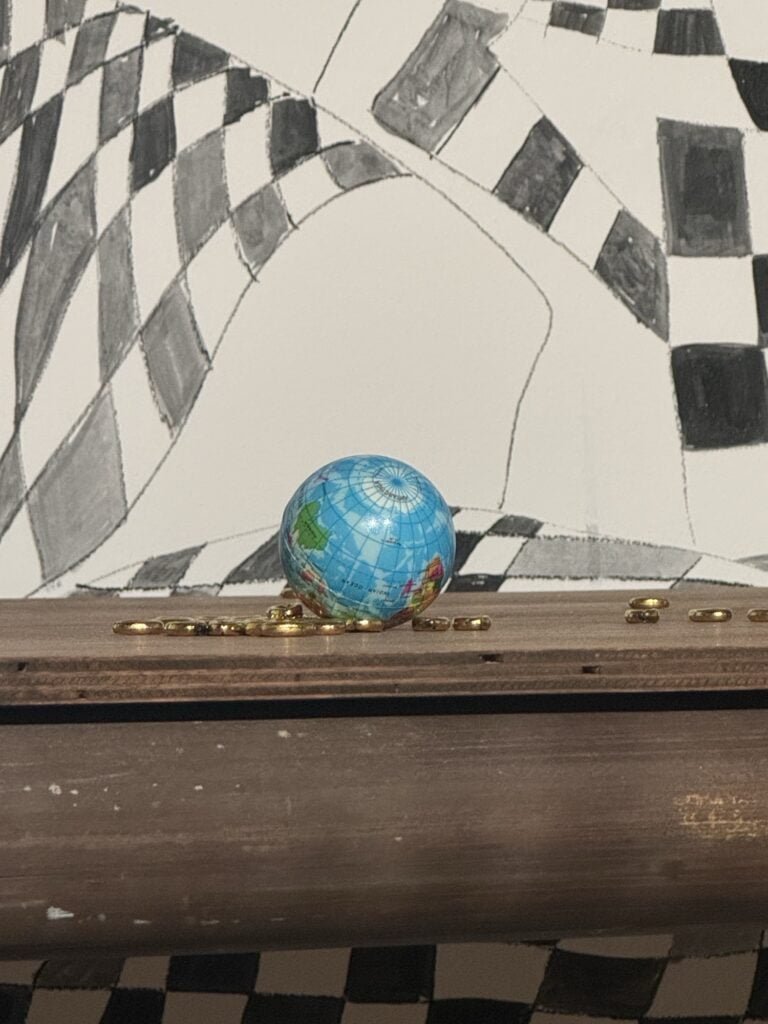
We popped into the Whitechapel Gallery yesterday and saw some uninspiring installations and performance art but as you might expect I spotted a few globes hidden in the displays.
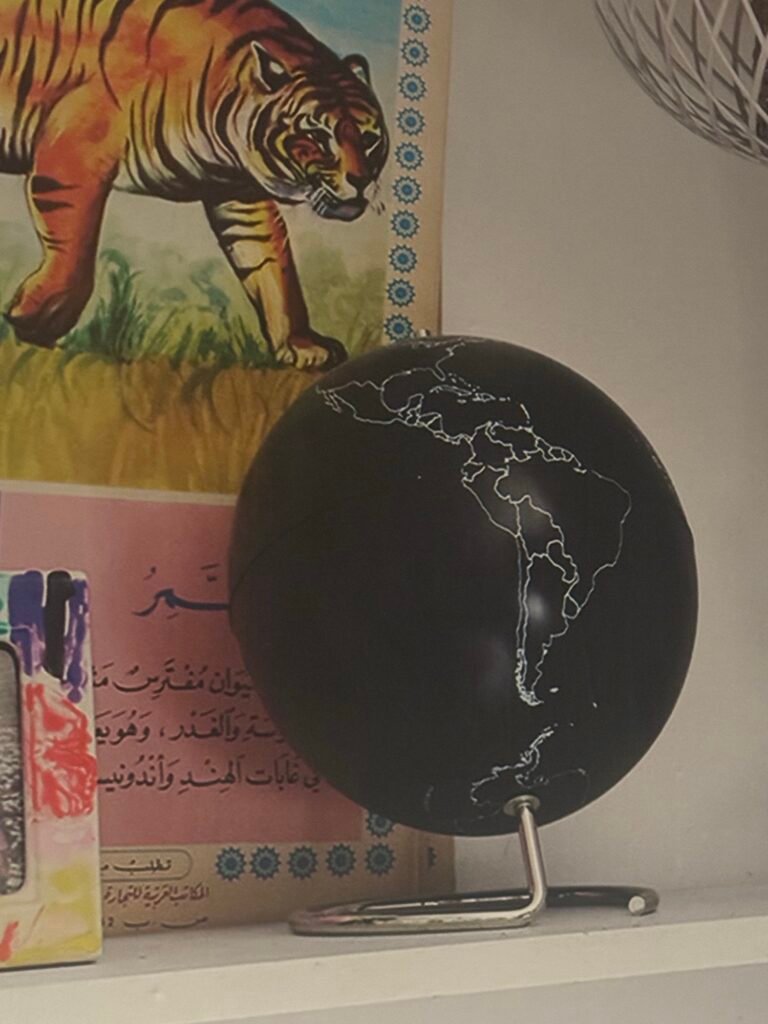
And this nice sign in the reception area
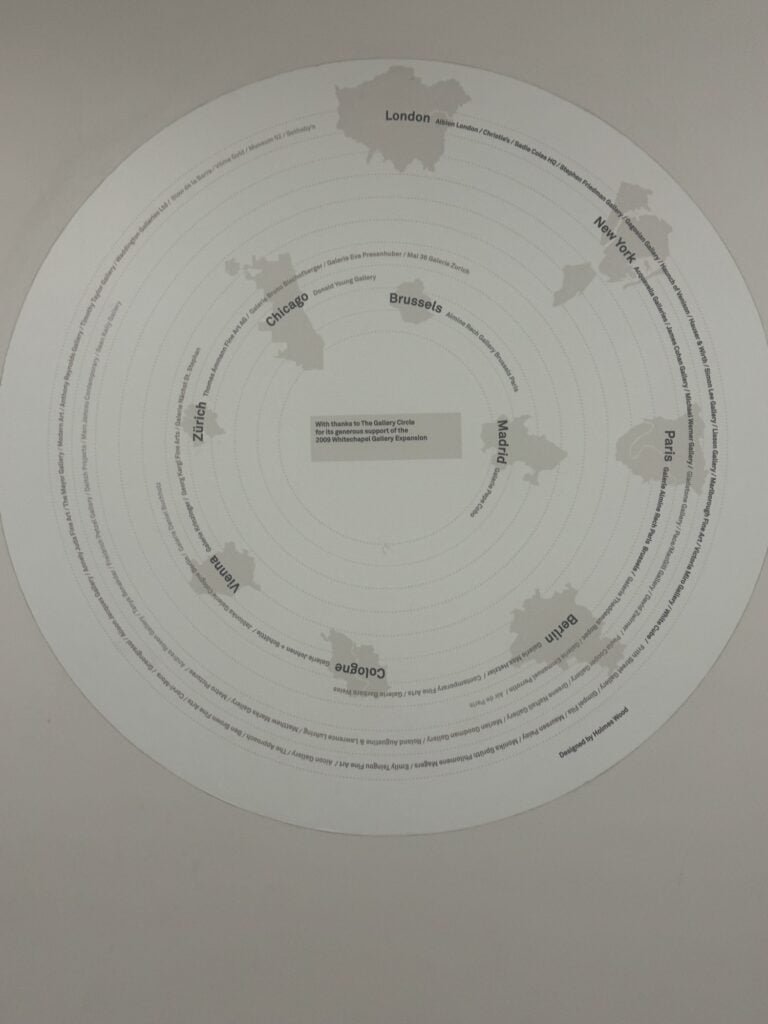
MapsintheWild Globes at the Whitechapel Gallery
-
sur The Journey of a Vampire
Publié: 27 May 2024, 8:53am CEST par Keir Clarke
On a dark night in July, 1893, Count Dracula embarked on a long, secret journey from Transylvania aboard the ill-fated ship Demeter. Unbeknownst to the unsuspecting crew of the Demeter, a malevolent force lay hidden in the ship's hold—a coffin filled with the cursed soil of Dracula's homeland, concealing the vampire lord himself.By the time the Demeter's ghostly silhouette loomed over the
-
sur Mappery: President Obama by C215
Publié: 26 May 2024, 11:00am CEST

We finish this week’s series with US President Obama. I hope you enjoyed the series. C215 has been prolific on maps and old map boards, so stay tuned; there is more to come.
C215, Christian Guemy’s website c215.fr
MapsintheWild President Obama by C215
-
sur Mappery: Ben-Gurion by C215
Publié: 25 May 2024, 11:00am CEST
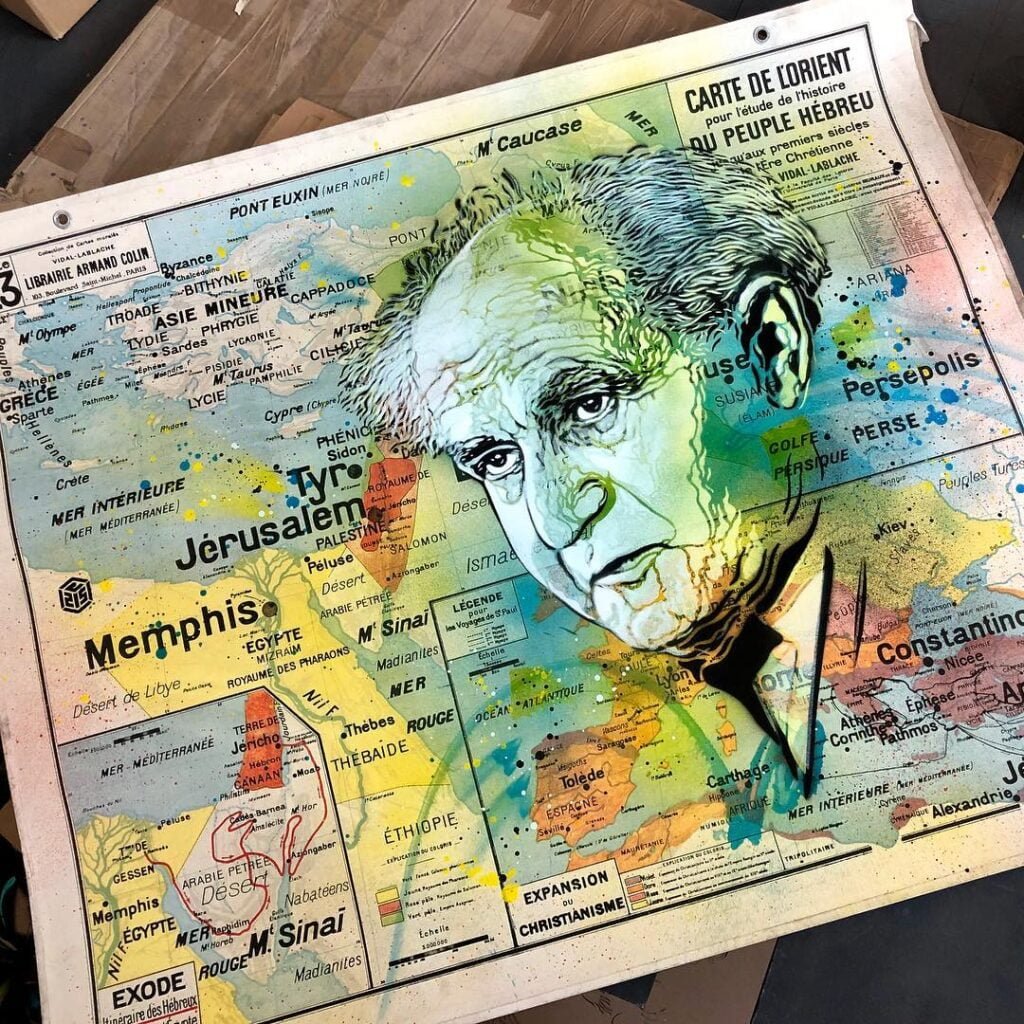
David Ben-Gurion, Israel’s first prime minister, stands resolute on a 1950s Vidal Lablache map depicting the ancient Near East and the biblical history of the Jewish people.
C215, Christian Guemy’s website c215.fr
MapsintheWild Ben-Gurion by C215
-
sur Old Maps Online
Publié: 25 May 2024, 10:06am CEST par Keir Clarke
Old Maps Online, MapTiler and the David Rumsey Map collection have launched TimeMap.org, a new interactive world map which allows you to explore the history of human civilization over the last 6,000 years. TimeMap promises to throw open the doors to the past, allowing you to explore bygone eras, trace the shifting boundaries of nations, encounter history's most powerful figures, and witness the
-
sur gvSIG Batoví: Nueva edición Curso – Concurso Geoalfabetización mediante la utilización de Tecnologías de la Información Geográfica
Publié: 24 May 2024, 9:10pm CEST

¡Vamos por el séptimo año!
El Curso – Concurso Geoalfabetización mediante la utilización de TIGs se desarrollará entre el 3 de junio y el 7 de noviembre y es organizado por la Dirección Nacional de Topografía (MTOP), la Inspección Nacional de Geografía y Geología (ANEP-DGES), Ceibal y la Universidad Politécnica de Madrid (España). Este año la iniciativa cuenta con la colaboración de la Dirección General de Educación Técnico-Profesional (UTU), la Asociación Nacional de Profesores de Geografía (ANPG) y la Universidad Central Marta Abreu de Las Villas (Cuba).
La iniciativa consta de 2 partes: primero: un curso denominado Tecnologías de la Información Geográfica y gvSIG Batoví dirigido a docentes de Enseñanza Media y Técnico-Profesional de Geografía y áreas relacionadas con el conocimiento geográfico, ambiental y social. La capacitación se desarrollará del 3 al 28 de junio en modalidad b-learning (plataforma + taller por videoconferencia).
Se entregará una certificación avalada por las instituciones organizadoras del curso, en la cual se reconocerá la participación satisfactoria de los cursillistas en la capacitación brindada (30 horas) y en el concurso posterior.
Para acceder a la certificación los inscriptos deberán completar el recorrido de los temas en la plataforma, asistir a los 3 días de taller, entregar las actividades propuestas y deberán también haber participado del concurso posterior.
Período de inscripción: del 27 de mayo al 2 de junio.
La segunda parte consiste en un concurso denominado Proyectos con Estudiantes y gvSIG Batoví. Los equipos de trabajo estarán integrados por estudiantes (de 3 a 5 alumnos) y al menos un docente de referencia (máx. 3), el cual debió participar en alguna edición del curso. Cada equipo deberá presentar un proyecto de trabajo que identifique y aborde una problemática de interés local, que posea una dimensión territorial y se enmarque en alguno de los Objetivos de Desarrollo Sostenible (ODS) 2030 de la Organización de las Naciones Unidas. Cada proyecto contará con un tutor que le proporcionará asesoría técnica y pedagógica.
En cuanto a la premiación, se seleccionarán 3 proyectos finalistas y de ellos el ganador del concurso. Los ganadores recibirán los premios propuestos por la organización y el resto de los equipos un certificado por su participación.
Dudas o consultas: batovi@ceibal.edu.uy
convocatoria-curso-tig-y-barovi-2024Descarga -
sur Mappery: Ho Chi Minh by C215
Publié: 24 May 2024, 11:00am CEST
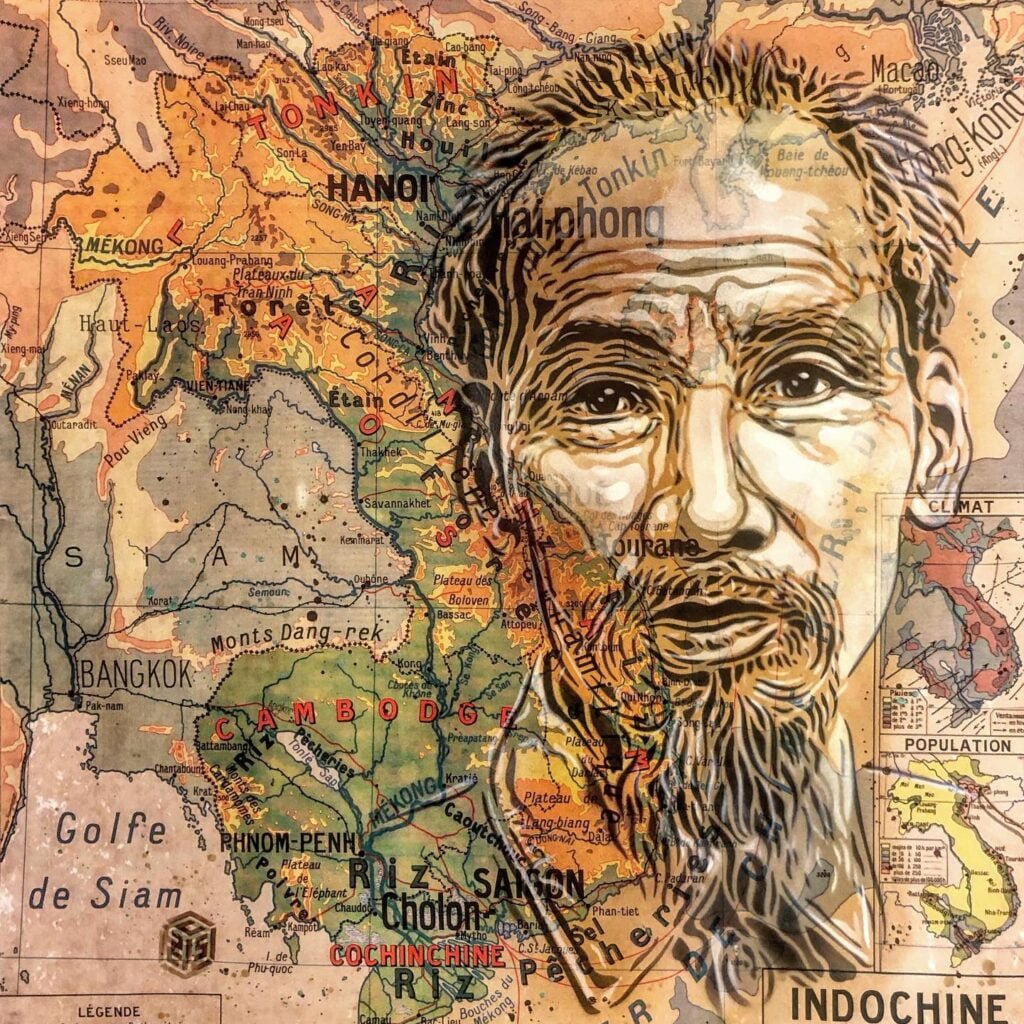
Revolutionary leader Ho Chi Minh gazes out from a vintage map of Vietnam. A symbol of resilience and national pride
C215, Christian Guemy’s website c215.fr
MapsintheWild Ho Chi Minh by C215
-
sur GeoTools Team: GeoTools 31.1 Released
Publié: 23 May 2024, 8:24pm CEST
GeoTools 31.1 released The GeoTools team is pleased to announce the release of the latest stable version of GeoTools 31.1: geotools-31.1-bin.zip geotools-31.1-doc.zip geotools-31.1-userguide.zip geotools-31.1-project.zip This release is also available from the OSGeo Maven Repository and is made in conjunction with GeoServer 2.25.1 and GeoWebCache 1.25.1. Thanks to Jody Garnett -
sur Fernando Quadro: O papel do Machine Learning no GIS
Publié: 23 May 2024, 2:00pm CEST
No domínio dos Sistemas de Informação Geográfica (GIS), o Machine Learning não é apenas uma palavra da moda, é uma força transformadora. É a chave para desbloquear todo o potencial dos dados geoespaciais, transformando conjuntos de dados vastos e complexos em insights acionáveis. Vamos nos aprofundar nos tipos de algoritmos de machine learning e suas aplicações em contextos geoespaciais.
 Aprendizagem supervisionada: A aprendizagem supervisionada é semelhante a ter um guia experiente no deserto de dados. Com conjuntos de dados rotulados, os algoritmos aprendem a prever resultados com base em exemplos anteriores. É perfeito para:
Aprendizagem supervisionada: A aprendizagem supervisionada é semelhante a ter um guia experiente no deserto de dados. Com conjuntos de dados rotulados, os algoritmos aprendem a prever resultados com base em exemplos anteriores. É perfeito para:
 Mapeamento de Habitat de Espécies: Prever onde certas espécies podem prosperar.
Mapeamento de Habitat de Espécies: Prever onde certas espécies podem prosperar.
 Categorização da Cobertura do Solo: Classificação de áreas com base na vegetação, desenvolvimento urbano ou corpos d’água.
Categorização da Cobertura do Solo: Classificação de áreas com base na vegetação, desenvolvimento urbano ou corpos d’água.
 Previsão Climática: Estimativa de padrões futuros de temperatura e precipitação.
Previsão Climática: Estimativa de padrões futuros de temperatura e precipitação. Aprendizagem não supervisionada: Algoritmos de aprendizagem não supervisionados são os exploradores intrépidos, encontrando estruturas ocultas em territórios desconhecidos de dados não rotulados. Eles se destacam em:
Aprendizagem não supervisionada: Algoritmos de aprendizagem não supervisionados são os exploradores intrépidos, encontrando estruturas ocultas em territórios desconhecidos de dados não rotulados. Eles se destacam em:
 Segmentação de imagens: Divisão de milhões de imagens de satélite em clusters significativos.
Segmentação de imagens: Divisão de milhões de imagens de satélite em clusters significativos.
 Detecção de anomalias: Identificação de padrões incomuns que possam indicar mudanças ambientais ou desenvolvimento urbano.
Detecção de anomalias: Identificação de padrões incomuns que possam indicar mudanças ambientais ou desenvolvimento urbano. Aprendizado profundo: O aprendizado profundo se aprofunda nos dados, usando redes neurais em camadas para processar informações de uma forma que imita o cérebro humano. Sua habilidade é evidente em:
Aprendizado profundo: O aprendizado profundo se aprofunda nos dados, usando redes neurais em camadas para processar informações de uma forma que imita o cérebro humano. Sua habilidade é evidente em:
 Classificação de Imagens: Distinguir entre diferentes usos do solo em imagens de satélite.
Classificação de Imagens: Distinguir entre diferentes usos do solo em imagens de satélite.
 Detecção de Objetos: Identificação e localização de objetos como veículos ou edifícios em fotos aéreas.
Detecção de Objetos: Identificação e localização de objetos como veículos ou edifícios em fotos aéreas.
 Análise de Séries Temporais: Monitoramento de mudanças ao longo do tempo, como desmatamento ou expansão urbana.
Análise de Séries Temporais: Monitoramento de mudanças ao longo do tempo, como desmatamento ou expansão urbana. Algoritmos Comuns: Os algoritmos mais comumente usados em análise geoespacial incluem:
Algoritmos Comuns: Os algoritmos mais comumente usados em análise geoespacial incluem:
 Random Forest: um método de conjunto robusto, ótimo para tarefas de classificação e regressão.
Random Forest: um método de conjunto robusto, ótimo para tarefas de classificação e regressão.
 Regressão Linear: Ideal para prever variáveis contínuas, como tendências de temperatura.
Regressão Linear: Ideal para prever variáveis contínuas, como tendências de temperatura.
 Regressão Logística e Árvores de Decisão: Útil para classificação binária, como áreas propensas a inundações.
Regressão Logística e Árvores de Decisão: Útil para classificação binária, como áreas propensas a inundações.
 K-Nearest Neighbors: Um método simples, mas eficaz para classificação com base na proximidade.
K-Nearest Neighbors: Um método simples, mas eficaz para classificação com base na proximidade.
 Naïve Bayes: Uma abordagem probabilística frequentemente usada para classificação de texto e filtragem de spam.
Naïve Bayes: Uma abordagem probabilística frequentemente usada para classificação de texto e filtragem de spam.
 K-Means Clustering: Um algoritmo não supervisionado que agrupa dados em k clusters distintos.
K-Means Clustering: Um algoritmo não supervisionado que agrupa dados em k clusters distintos.À medida que continuamos a aproveitar esses algoritmos, não estamos apenas mapeando o mundo, estamos moldando-o. O futuro da análise geoespacial está aqui e é inteligente, dinâmico e incrivelmente emocionante.
Gostou desse post? Conte nos comentários

-
sur Mappery: What matters is Love by C215
Publié: 23 May 2024, 11:00am CEST
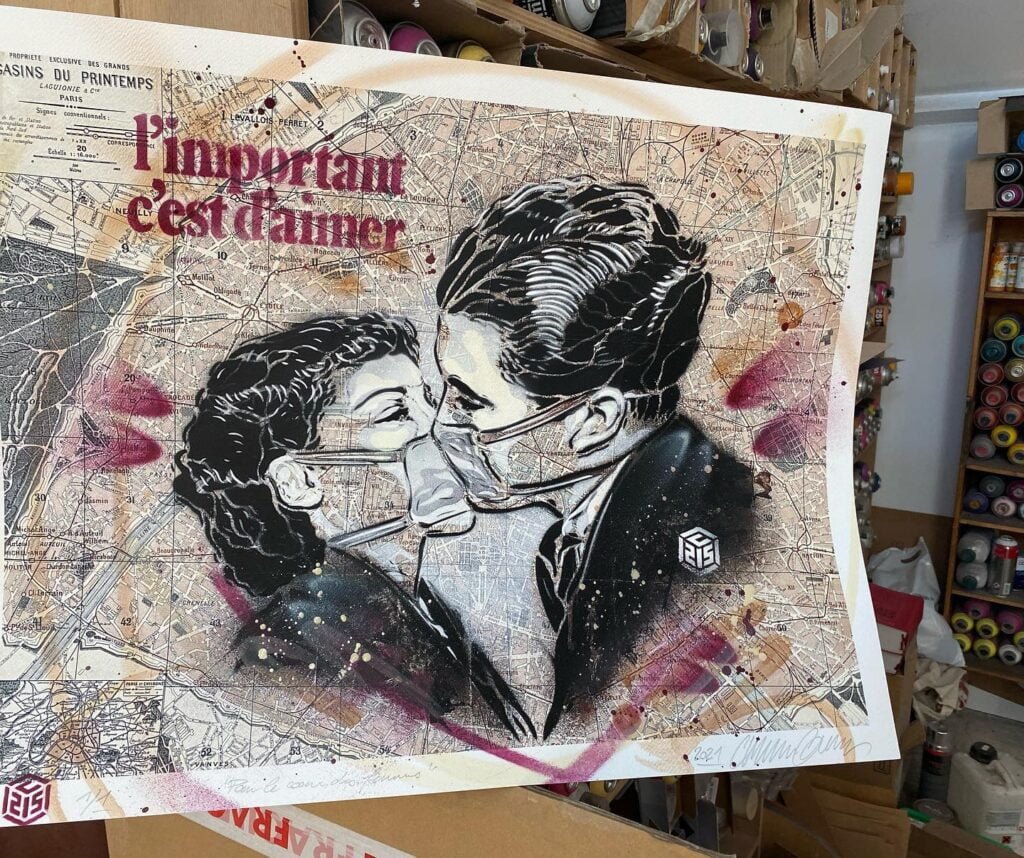
A masked Parisian embrace painted over a map of the City of Lights. C215 reminds us: “l’important c’est d’aimer” (what matters is love).
C215, Christian Guemy’s website c215.fr
MapsintheWild What matters is Love by C215
-
sur GeoSolutions: Building and Consuming Urban Digital Twins with Open-Source Tools
Publié: 23 May 2024, 8:01am CEST
You must be logged into the site to view this content.
-
sur Guess This City - Daily Challenge
Publié: 23 May 2024, 7:55am CEST par Keir Clarke
Unveil the World with 'Guess This City': A New Daily Map-Based GameGet ready to embark on a new global adventure from the comfort of your home with the launch of 'Guess This City,' a new daily map-based game. Every day brings a new test of your geographical knowledge and deduction skills as you are challenged to identify hidden cities by revealing parts of a map, one click at a time.Discover
-
sur GeoTools Team: GeoTools 30.3 released
Publié: 23 May 2024, 2:51am CEST
The GeoTools team is pleased to the release of the latest stable version of GeoTools 30.3:geotools-30.3-bin.zip geotools-30.3-doc.zip geotools-30.3-userguide.zip geotools-30.3-project.zip This release is also available from the OSGeo Maven Repository and is made in conjunction with GeoServer 2.24.3. The release was made by Andrea Aime (Geosolutions). -
sur GeoServer Team: GeoServer 2.25.1 Release
Publié: 23 May 2024, 2:00am CEST
GeoServer 2.25.1 release is now available with downloads (bin, war, windows), along with docs and extensions.
This is a stable release of GeoServer recommended for production use. GeoServer 2.25.1 is made in conjunction with GeoTools 31.1, and GeoWebCache 1.25.1.
Thanks to Jody Garnett (GeoCat) for making this release.
Security ConsiderationsThis release addresses security vulnerabilities and is considered an essential upgrade for production systems.
See project security policy for more information on how security vulnerabilities are managed.
Raster Attribute Table ExtensionA new extension is available that takes advantage of the GDAL Raster Attribute Table (RAT). This data structure provides a way to associate attribute information for individual pixel values within the raster. This provides a table that links each cell value in the raster to one or more attributes on the fly.

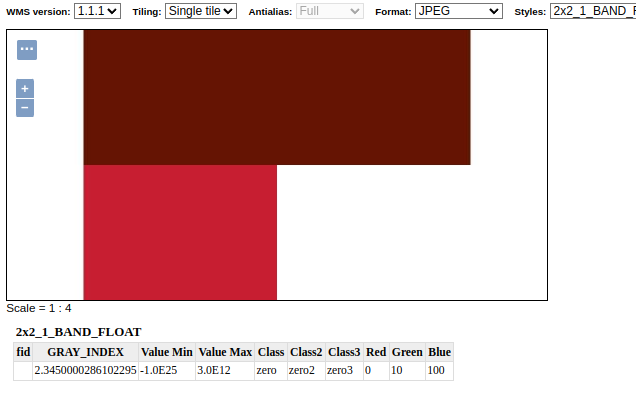
Thanks to Andrea Aime (GeoSolutions) for the development and NOAA for sponsoring this new capability. Please see the user guide Raster Attribute Table support for more information.
- GEOS-11376 Graduate Raster Attribute Table to extension
New Feature:
- GEOS-11267 CSW ISO extension multiple mappings should also have multiple queryable mappings
- GEOS-11376 Graduate Raster Attribute Table to extension
Improvement:
- GEOS-11306 Java 17 does not support GetFeature lazy JDBC count(*)
- GEOS-11311 Show a full stack trace in the JVM stack dump panel
- GEOS-11342 STAC should exclude items when the collection in path is wrong
- GEOS-11359 Update MapML viewer to release 0.13.2
-
GEOS-11369 Additional authentication options for cascaded WMS WMTS data stores - GEOS-11377 RAT module: allow to reload/recompute the RAT
- GEOS-11400 About Page Layout and display of build information
- GEOS-11401 Introduce environmental variables for Module Status page
Bug:
- GEOS-11202 CAS extension doesn’t use global “proxy base URL” setting for service ticket
- GEOS-11236 WFS 2.0.0/GetFeature - Shapefile - “We have had issues trying to flip axis”
- GEOS-11331 OAuth2 can throw a “ java.lang.RuntimeException: Never should reach this point”
- GEOS-11332 Renaming style with uppercase/downcase empty the sld file
- GEOS-11382 The interceptor “CiteComplianceHack” never gets invoked by the Dispatcher Servlet
- GEOS-11385 Demo Requests functionality does not honour ENV variable PROXY_BASE_URL
- GEOS-11392 ConcurrentModificationException while using proxy-base-ext
Task:
- GEOS-11360 Upgrade Apache POI from 4.1.1 to 5.2.5
- GEOS-11362 Upgrade Spring libs from 5.3.32 to 5.3.33
- GEOS-11374 Upgrade Spring version from 5.3.33 to 5.3.34
- GEOS-11375 GSIP 224 - Individual contributor clarification
- GEOS-11388 Update ImageIO-EXT to 1.4.10
- GEOS-11393 Upgrade commons-io from 2.12.0 to 2.16.1
- GEOS-11395 Upgrade guava from 32.0.0 to 33.2.0
- GEOS-11397 App-Schema Includes fix Integration Tests
- GEOS-11402 Upgrade PostgreSQL driver from 42.7.2 to 42.7.3
- GEOS-11403 Upgrade commons-text from 1.10.0 to 1.12.0
- GEOS-11404 Upgrade commons-codec from 1.15 to 1.17.0
For the complete list see 2.25.1 release notes.
Community UpdatesCommunity module development:
- GEOS-11040 Could not get a ServiceInfo for service Features thus could not check if the service is enabled
- GEOS-11330 OAuth2 kid verification should be optional
- GEOS-11339 Introducing the Features Autopopulate Community Plugin
- GEOS-11340 WFS Freemarker HTML Outputformat
- GEOS-11345 STAC Conformance URIs need to be updated to v1.0.0
- GEOS-11348 JMS cluster does not allow to publish style via REST “2 step” approach
- GEOS-11358 Feature-Autopopulate Update operation does not apply the Update Element filter
- GEOS-11381 Error in OIDC plugin in combination with RoleService
- GEOS-11394 OGC APIs cannot handle time extent when the source data type is java.sql.Date
Community modules are shared as source code to encourage collaboration. If a topic being explored is of interest to you, please contact the module developer to offer assistance.
About GeoServer 2.25 SeriesAdditional information on GeoServer 2.25 series:
-
sur GeoServer Team: GeoServer 2.25.1 Release
Publié: 23 May 2024, 2:00am CEST
GeoServer 2.25.1 release is now available with downloads (bin, war, windows), along with docs and extensions.
This is a stable release of GeoServer recommended for production use. GeoServer 2.25.1 is made in conjunction with GeoTools 31.1, and GeoWebCache 1.25.1.
Thanks to Jody Garnett (GeoCat) for making this release.
Security ConsiderationsThis release addresses security vulnerabilities and is considered an essential upgrade for production systems.
See project security policy for more information on how security vulnerabilities are managed.
Raster Attribute Table ExtensionA new extension is available that takes advantage of the GDAL Raster Attribute Table (RAT). This data structure provides a way to associate attribute information for individual pixel values within the raster. This provides a table that links each cell value in the raster to one or more attributes on the fly.


Thanks to Andrea Aime (GeoSolutions) for the development and NOAA for sponsoring this new capability. Please see the user guide Raster Attribute Table support for more information.
- GEOS-11376 Graduate Raster Attribute Table to extension
New Feature:
- GEOS-11267 CSW ISO extension multiple mappings should also have multiple queryable mappings
- GEOS-11376 Graduate Raster Attribute Table to extension
Improvement:
- GEOS-11306 Java 17 does not support GetFeature lazy JDBC count(*)
- GEOS-11311 Show a full stack trace in the JVM stack dump panel
- GEOS-11342 STAC should exclude items when the collection in path is wrong
- GEOS-11359 Update MapML viewer to release 0.13.2
-
GEOS-11369 Additional authentication options for cascaded WMS WMTS data stores - GEOS-11377 RAT module: allow to reload/recompute the RAT
- GEOS-11400 About Page Layout and display of build information
- GEOS-11401 Introduce environmental variables for Module Status page
Bug:
- GEOS-11202 CAS extension doesn’t use global “proxy base URL” setting for service ticket
- GEOS-11236 WFS 2.0.0/GetFeature - Shapefile - “We have had issues trying to flip axis”
- GEOS-11331 OAuth2 can throw a “ java.lang.RuntimeException: Never should reach this point”
- GEOS-11332 Renaming style with uppercase/downcase empty the sld file
- GEOS-11382 The interceptor “CiteComplianceHack” never gets invoked by the Dispatcher Servlet
- GEOS-11385 Demo Requests functionality does not honour ENV variable PROXY_BASE_URL
- GEOS-11392 ConcurrentModificationException while using proxy-base-ext
Task:
- GEOS-11360 Upgrade Apache POI from 4.1.1 to 5.2.5
- GEOS-11362 Upgrade Spring libs from 5.3.32 to 5.3.33
- GEOS-11374 Upgrade Spring version from 5.3.33 to 5.3.34
- GEOS-11375 GSIP 224 - Individual contributor clarification
- GEOS-11388 Update ImageIO-EXT to 1.4.10
- GEOS-11393 Upgrade commons-io from 2.12.0 to 2.16.1
- GEOS-11395 Upgrade guava from 32.0.0 to 33.2.0
- GEOS-11397 App-Schema Includes fix Integration Tests
- GEOS-11402 Upgrade PostgreSQL driver from 42.7.2 to 42.7.3
- GEOS-11403 Upgrade commons-text from 1.10.0 to 1.12.0
- GEOS-11404 Upgrade commons-codec from 1.15 to 1.17.0
For the complete list see 2.25.1 release notes.
Community UpdatesCommunity module development:
- GEOS-11040 Could not get a ServiceInfo for service Features thus could not check if the service is enabled
- GEOS-11330 OAuth2 kid verification should be optional
- GEOS-11339 Introducing the Features Autopopulate Community Plugin
- GEOS-11340 WFS Freemarker HTML Outputformat
- GEOS-11345 STAC Conformance URIs need to be updated to v1.0.0
- GEOS-11348 JMS cluster does not allow to publish style via REST “2 step” approach
- GEOS-11358 Feature-Autopopulate Update operation does not apply the Update Element filter
- GEOS-11381 Error in OIDC plugin in combination with RoleService
- GEOS-11394 OGC APIs cannot handle time extent when the source data type is java.sql.Date
Community modules are shared as source code to encourage collaboration. If a topic being explored is of interest to you, please contact the module developer to offer assistance.
About GeoServer 2.25 SeriesAdditional information on GeoServer 2.25 series:
-
sur Camptocamp: Camptocamp Sponsors Two PostgreSQL Events in June: pgday.fr and pgday.ch
Publié: 23 May 2024, 2:00am CEST
Pièce jointe: [télécharger]
As a company committed to supporting our clients in deploying, optimizing, monitoring, securing, and utilizing PostgreSQL, we have decided to extend our support to the PostgreSQL community by sponsoring these conferences at the "supporters" level. -
sur Camptocamp: Camptocamp Sponsors Two PostgreSQL Events in June: pgday.fr and pgday.ch
Publié: 23 May 2024, 2:00am CEST
Pièce jointe: [télécharger]
As a company committed to supporting our clients in deploying, optimizing, monitoring, securing, and utilizing PostgreSQL, we have decided to extend our support to the PostgreSQL community by sponsoring these conferences at the "supporters" level. -
sur Camptocamp: Camptocamp Sponsors Two PostgreSQL Events in June: pgday.fr and pgday.ch
Publié: 23 May 2024, 2:00am CEST
Pièce jointe: [télécharger]
As a company committed to supporting our clients in deploying, optimizing, monitoring, securing, and utilizing PostgreSQL, we have decided to extend our support to the PostgreSQL community by sponsoring these conferences at the "supporters" level. -
sur Camptocamp: Camptocamp Sponsors Two PostgreSQL Events in June: pgday.fr and pgday.ch
Publié: 23 May 2024, 2:00am CEST
Pièce jointe: [télécharger]
As a company committed to supporting our clients in deploying, optimizing, monitoring, securing, and utilizing PostgreSQL, we have decided to extend our support to the PostgreSQL community by sponsoring these conferences at the "supporters" level.
-
sur Registrations Open for OGC’s July 2024 Open Standards Code Sprint
Publié: 22 May 2024, 3:00pm CEST par Simon Chester
The Open Geospatial Consortium (OGC) invites developers and other contributors to the July 2024 Open Standards Code Sprint, to be held from July 10-12 in London and online. Participation is free and open to the public, with travel support funding available to select participants. Sponsorship opportunities are also available.
The Code Sprint is sponsored by OGC Principal Member Google at the Silver Level, with additional Strategic Member support from Natural Resources Canada (NRCan).
This will be a collaborative and inclusive event to support the development of open Standards and applications that implement those Standards. All OGC Standards are in scope for this Code Sprint, including OGC API Standards. The Sprint will feature three special tracks on Data Quality & Artificial Intelligence, Validators, and the Map Markup Language (MapML).
OGC Code Sprints experiment with emerging ideas in the context of geospatial Standards and help improve interoperability of existing Standards by experimenting with new extensions or profiles. They are also used for building proofs-of-concept to support standards development activities and the enhancement of software products.
Non-coding activities such as testing, working on documentation, or reporting issues are welcome during the Code Sprint. OGC Sprints also provide an opportunity to onboard developers that are new to OGC Standards, through the sprints’ mentor streams.
Organizations are invited to sponsor the Code Sprint. A range of packages are available offering different opportunities for organizations to support the geospatial development community while promoting their products or services. Visit the Event Sponsorship page for more information.
A one-hour pre-event webinar will take place at 14:00 BST (UTC+1) on June 13. The webinar will outline the scope of work for the Code Sprint and provide an overview of the specifications that will be its focus. The pre-event webinar will take place on OGC’s Discord server.
Travel Support Funding is available for selected participants. Participants interested in receiving travel support funding should indicate their interest on the registration form. Any participant applying for funding will need to submit their registration form by June 30. Applicants will be notified within 2 weeks of their application whether travel support will be available to them or not.
The code sprint will begin with an onboarding session at 09:00 (UTC+1) on July 10, and ends at 17:00 (UTC+1) on July 12. Registration for in-person participation closes at 17:00 (UTC+1) on July 3. Registration for remote participation will remain open throughout the Code Sprint.
Registration is available on the July 2024 Code Sprint website. To learn more about future and previous OGC code sprints, visit the OGC Developer Events Wiki, the OGC Code Sprints Website, or join OGC’s Discord server.
The post Registrations Open for OGC’s July 2024 Open Standards Code Sprint appeared first on Open Geospatial Consortium.
-
sur Fernando Quadro: Geoprocessamento na Saúde
Publié: 22 May 2024, 2:00pm CEST
A localização de eventos de saúde no espaço geográfico com base em mapas não é recente. Em 1854, o médico John Snow investigou no bairro de Soho, em Londres, um surto de cólera. Ele mapeou com base nos croquis dos quarteirões, as casas atingidas e relacionou com as pessoas que beberam água de uma fonte na Broad Street.
Logo, percebeu que aquele surto em particular ocorrera em torno de uma bomba de água compartilhada que a maioria dos habitantes usava para coletar água para beber e lavar. Essa foi a primeira vez que um mapa foi usado para melhor compreensão de uma doença e estabelecer medidas de controle.
Várias são as possibilidades do uso do geoprocessamento na saúde:
 Serviços de saúde,
Serviços de saúde,
 Saúde ambiental,
Saúde ambiental,
 Epidemiologia de doenças crônicas não transmissíveis,
Epidemiologia de doenças crônicas não transmissíveis,
 Epidemiologia de doenças transmissíveis,
Epidemiologia de doenças transmissíveis,
 Identificação de áreas de risco,
Identificação de áreas de risco,
 Entre outros…
Entre outros…A melhora e o aumento na disponibilidade de bases de dados e dos SIG trouxeram ganhos importantíssimos para aplicação do geoprocessamento na área da saúde. Podemos citar os Sistemas de Informação em Saúde que abarcam dados sobre nascimentos, óbitos e doenças de notificação compulsória, entre eles:
 Sistema de Informação de Mortalidade (SIM),
Sistema de Informação de Mortalidade (SIM),
 Sistema de Nascidos Vivos (SINASC) ,
Sistema de Nascidos Vivos (SINASC) ,
 Sistema de Informação de Agravos de Notificação (SINAN).
Sistema de Informação de Agravos de Notificação (SINAN). As possibilidades de técnicas disponíveis em SIGs robustos, permitem análises que são úteis na identificação de áreas de risco para determinados agravos, bem como na análise destes que busquem relação com variáveis ambientais extraídas de informações sobre uso e ocupação do solo ou de variáveis climáticas, extraídas de produtos de sensoriamento remoto e de métodos de reanálise para o monitoramento climático; ou na combinação de variáveis, ambientais, climáticas socioeconômicas a partir do uso de modelos estatísticos espaciais que permite tratar a heterogeneidade espacial e espaço temporal, levando em conta tanto a vizinhança (a dependência espacial) como a existência de estruturas hierárquicas de dados em questão.
Em resumo, a aplicação do geoprocessamento e das técnicas de análise espacial associadas ao acesso livre e gratuito de SIGs e de inúmeras fontes de dados, vem abrindo oportunidades de uso na área de saúde pública, não somente para pesquisadores em seus estudos, mas especialmente para os profissionais que atuam na área da saúde.
Gostou desse post? Conte nos comentários

-
sur Mappery: Antoine de Saint Exupery by C215
Publié: 22 May 2024, 11:00am CEST
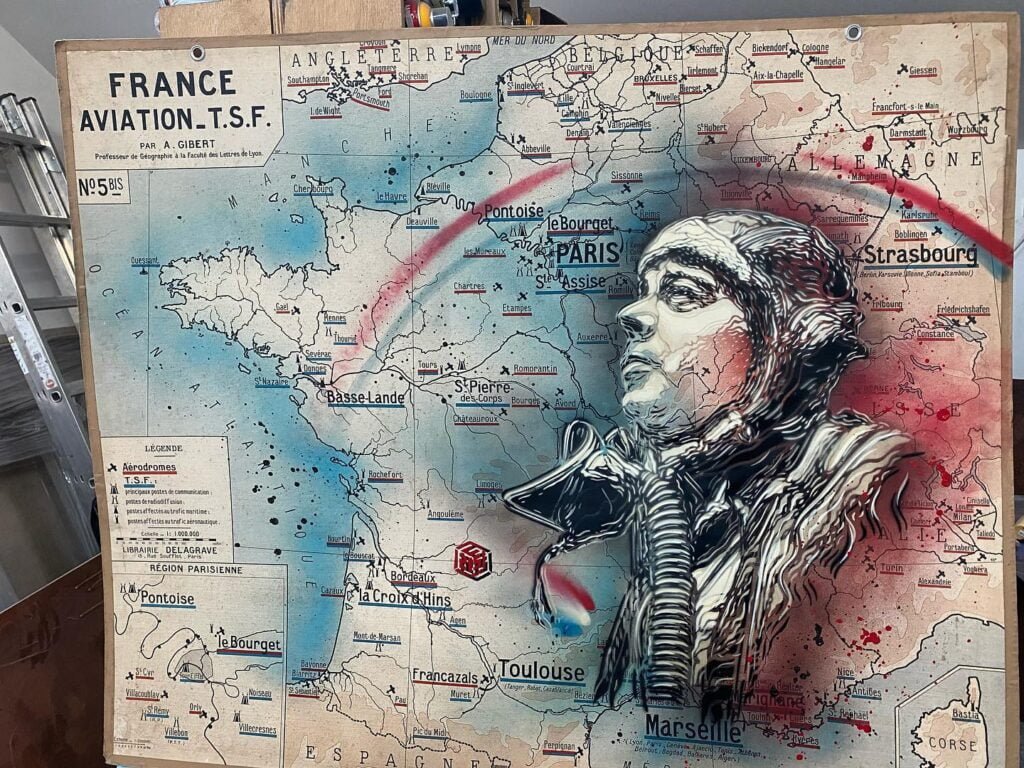
French author Antoine de Saint-Exupéry, known for “The Little Prince,” soars over his homeland on a vintage map of France. Where will imagination take you today?
C215, Christian Guemy Website : c215.fr
MapsintheWild Antoine de Saint Exupery by C215
-
sur It's War on the Streets of Paris
Publié: 22 May 2024, 8:37am CEST par Keir Clarke
Une Histoire de Rue is a new interactive map which explores the connections between Paris street names and military history. Around 15% of Paris' streets have names which are related to battles, soldiers and/or resistance fighters. This new interactive map allows you to quickly see the extent to which military history is reflected and commemorated in the names of Paris' roads.On the map streets
-
sur Camptocamp: NexSIS - the Go Live!
Publié: 22 May 2024, 2:00am CEST
Pièce jointe: [télécharger]
At the start of the NexSIS project in 2019, the Digital Agency for Civil Security (ANSC) chose to entrust the development of the cartographic features of its applications to the teams at Camptocamp. -
sur Camptocamp: NexSIS - the Go Live!
Publié: 22 May 2024, 2:00am CEST
Pièce jointe: [télécharger]
At the start of the NexSIS project in 2019, the Digital Agency for Civil Security (ANSC) chose to entrust the development of the cartographic features of its applications to the teams at Camptocamp. -
sur Fernando Quadro: Curso Combo PostgreSQL, PostGIS e GeoServer
Publié: 21 May 2024, 2:00pm CEST
Neste mês de maio a Geocursos está com inscrições abertas para seu Curso Combo com PostgreSQL, PostGIS e GeoServer, uma formação completa, saindo do zero em banco de dados (PostgreSQL/PostGIS), passando pela linguagem SQL, análises espaciais no PostGIS até a publicação completa de seus mapas na internet com o GeoServer.
O mercado de trabalho está cada vez mais competitivo, e o conhecimento em banco de dados (PostgreSQL/PostGIS) e servidor de mapas (GeoServer) tem sido cada vez mais um pré-requisito para qualquer profissional na área do Geoprocessamento.
Pensando nisso, a Geocursos está disponibilizando um cupom de R$ 270 reais de desconto pra você, basta ir no nosso WhatsApp e dizer “QUERO DESCONTO“.
 Você ficou interessado?
Você ficou interessado? -
sur Mappery: Africa Lion by C215
Publié: 21 May 2024, 11:00am CEST
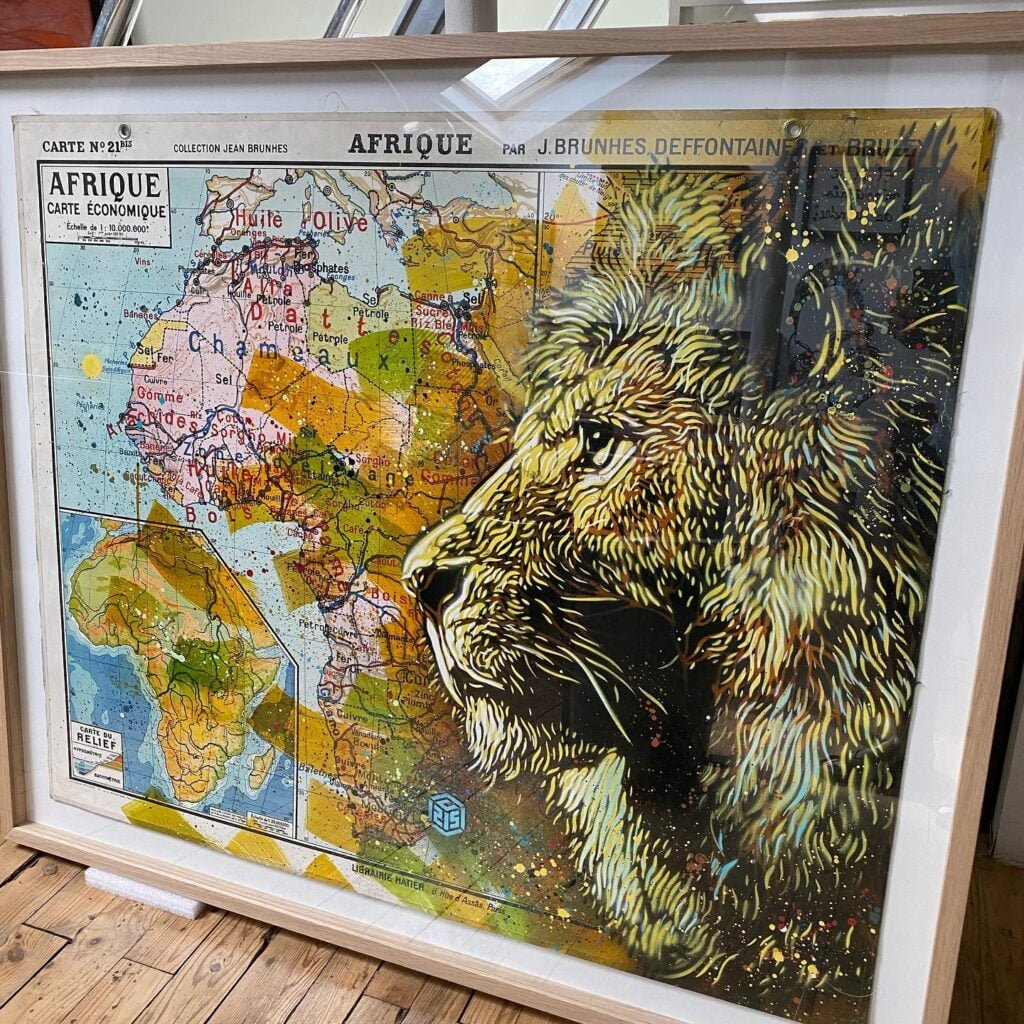
For our second episode, I chose this powerful image of a lion standing proudly over a map of Africa. It evokes the continent’s rich wildlife and the lion’s reign as the apex predator in the savannas and grasslands.
C215, Christian Guemy’s English website c215.fr
MapsintheWild Africa Lion by C215
-
sur 99 Red Balloons Go By
Publié: 21 May 2024, 8:11am CEST par Keir Clarke
Reuters reports that since December China has sent more than 100 balloons over Taiwan, often passing through air corridors used by civilian aircraft. It is unknown what the balloons are being used for, they could be weather balloons, but many suspect that they are being used to spy on Taiwan.You may remember that in February last year many Americans became enraged by the presence of a Chinese
-
sur Free and Open Source GIS Ramblings: New Trajectools 2.1 and MovingPandas 0.18 releases
Publié: 20 May 2024, 5:07pm CEST
Today marks the 2.1 release of Trajectools for QGIS. This release adds multiple new algorithms and improvements. Since some improvements involve upstream MovingPandas functionality, I recommend to also update MovingPandas while you’re at it.

If you have installed QGIS and MovingPandas via conda / mamba, you can simply:
conda activate qgis mamba install movingpandas=0.18Afterwards, you can check that the library was correctly installed using:
import movingpandas as mpd
mpd.show_versions()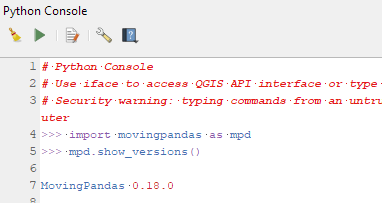 Trajectools 2.1
Trajectools 2.1
The new Trajectools algorithms are:
- Trajectory overlay — Intersect trajectories with polygon layer
- Privacy — Home work attack (requires scikit-mobility)
- This algorithm determines how easy it is to identify an individual in a dataset. In a home and work attack the adversary knows the coordinates of the two locations most frequently visited by an individual.
- GTFS — Extract segments (requires gtfs_functions)
- GTFS — Extract shapes (requires gtfs_functions)
- These algorithms extract public transport routes (GTFS shapes) and route segments between stops (GTFS segments) from GTFS ZIP files using gtfs_functions.Feed.shapes and .segments, respectively.
Furthermore, we have fixed issue with previously ignored minimum trajectory length settings.


Scikit-mobility and gtfs_functions are optional dependencies. You do not need to install them, if you do not want to use the corresponding algorithms. In any case, they can be installed using mamba and pip:
MovingPandas 0.18mamba install scikit-mobility pip install gtfs_functionsThis release adds multiple new features, including
- Method chaining support for add_speed(), add_direction(), and other functions
- New TrajectoryCollection.get_trajectories(obj_id) function
- New trajectory splitter based on heading angle
- New TrajectoryCollection.intersection(feature) function
- New plotting function hvplot_pts()
- Faster TrajectoryCollection operations through multi-threading
- Added moving object weights support to trajectory aggregator


-
sur Spreading Love & Peace in Nutopia
Publié: 20 May 2024, 11:13am CEST par Keir Clarke
Nutopia is a conceptual country which was created by John Lennon and Yoko Ono in 1973 as a form of artistic expression and social commentary. Nutopia was created to be a utopian country with no land, no borders, and no passports, symbolizing an idea of peace and global citizenship.The country of Nutopia has a white flag, symbolizing its surrender to peace, and its national anthem is a few
-
sur Mappery: Aime Cesaire by c215
Publié: 20 May 2024, 11:00am CEST
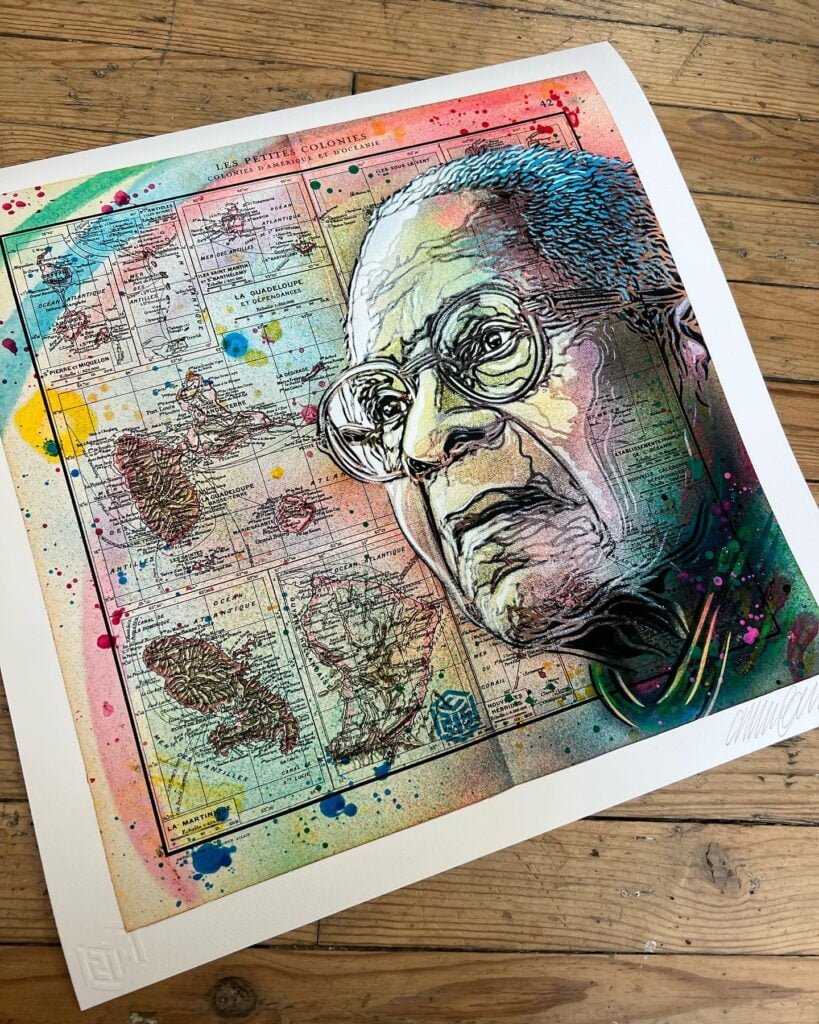
This week, we start a series with the artist Christian Guemy. C215, Christian Guemy’s artistic pseudonym, is a French street artist renowned for his unique blend of historical figures and vintage map boards. By transforming these weathered maps into canvases, C215 breathes new life into forgotten objects while leaving a powerful commentary on the passage of time and the enduring legacy of influential figures.
A Fusion of Past and Present
C215’s signature style involves meticulously stencilling portraits of iconic individuals—activists, scientists, artists, and more—directly onto the aged surfaces of map boards. These maps, often discarded or forgotten, become powerful symbols of the past. By juxtaposing these historical figures with the faded geography, C215 compels viewers to contemplate the connection between the past, present, and future.
A Street Art Pioneer
C215 is considered a pioneer of the French street art movement. He emerged in the early 2000s, bringing his art form to the streets of Paris and beyond. His work can be found adorning walls, buildings, and even abandoned spaces throughout Europe and across the globe.
More Than Just Portraits
While portraits are a defining element of C215’s art, his work delves into social commentary. He has used his stencils to address issues of war, poverty, and environmental degradation. The weathered maps themselves become a metaphor for the fragility of our world and the need to learn from the past.
C215’s art transcends the boundaries of traditional street art. By using vintage map boards as his canvas, he creates a powerful dialogue between past and present, reminding us of the enduring impact of history’s figures and the importance of learning from their legacies.
For further exploration, you can search online for:
- Images of C215’s street art
- Interviews with C215
C215 website is c215.fr (link to the English version).
MapsintheWild Aime Cesaire by c215
-
sur Mappery: Planet Gummi
Publié: 19 May 2024, 11:00am CEST
-
sur Mappery: Enter through the Mappy Doors
Publié: 18 May 2024, 11:00am CEST

Reinder sent this pic of the entrance to the Dutch National Archive, he said “It’s hard to see – but these glass doors in the Dutch National Archives in The Hague do contain a cartographic image of the Netherlands”.
Instead of through the looking glass, we have through the cartograph ?
MapsintheWild Enter through the Mappy Doors
-
sur Man Made Star Signs
Publié: 18 May 2024, 9:27am CEST par Keir Clarke
Space Trash Signs has hit upon a novel and fascinating way of visualizing the problems of space pollution. According to NASA there are around 9,000 tonnes of debris now floating around Earth at speeds of up to 25,000 km an hour. Space Trash Signs uses this debris to create new astronomical constellations or 'star signs'.In 1978 NASA scientist Donald J. Kessler published a paper which
-
sur Mappery: OS Picnic Blanket
Publié: 17 May 2024, 12:00pm CEST
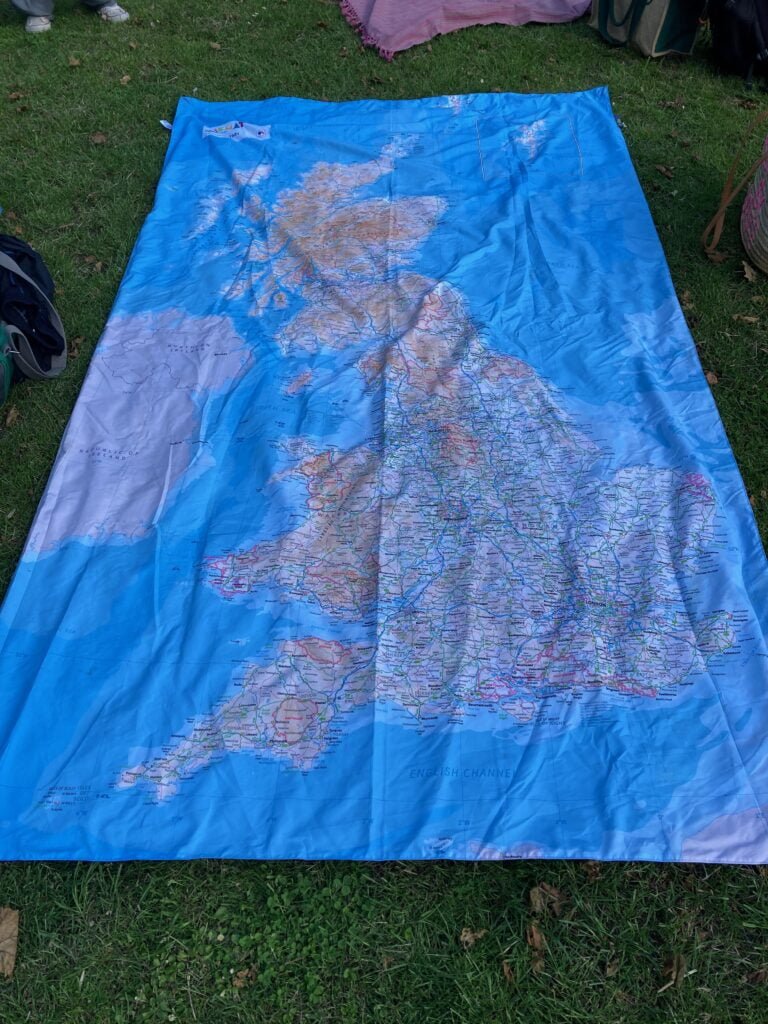
When your Canadian friends have just arrived in London and have settled in. I must admit I am still a bit jealous of their blanket.
MapsintheWild OS Picnic Blanket
-
sur Segregation in the U.S.
Publié: 17 May 2024, 7:56am CEST par Keir Clarke
Stanford University's Segregation Explorer visualizes the levels of segregation between schools and school districts in the United States. Developed by the Educational Opportunity Project at Stanford University, this new interactive map shows the levels of segregation across various regions, including states, metropolitan areas, school districts, and neighborhoods.The new map includes
-
sur Martin Davis: JTS Topological Relationships - the Next Generation
Publié: 16 May 2024, 11:41pm CEST
The most fundamental and widely-used operations in the JTS Topology Suite are the ones that evaluate topological relationships between geometries. JTS implements the Dimensionally-Extended 9 Intersection Model (DE-9IM), as defined in the OGC Simple Features specification, in the RelateOp API.
 DE-9IM matrix for overlapping polygons
DE-9IM matrix for overlapping polygonsThe RelateOp algorithm was the very first one implemented during the initial JTS development, over 20 years ago. At that time it was an appealing idea to implement a general-purpose topology framework (the GeometryGraph package), and use it to support topological predicates, overlay, and buffering. However, some disadvantages of this approach have become evident over time:
- the need to create a topological graph structure limits the ability to improve performance. This has led to the implementation of PreparedGeometry - but that adds further complexity to the codebase, and supports only a limited set of predicates.
- a large number of code dependencies make it hard to fix problems and improve semantics
- constructing a full topology graph increases exposure to geometric robustness errors
- GeometryCollections are not supported (initially because the OGC did not define the semantics for this, and now because adding this capability is difficult)
The importance of this functionality is especially significant since the same algorithm is implemented in GEOS. That codebase is used to evaluate spatial queries in popular spatial APIs such as Shapely and R-sf, and numerous systems such as PostGIS, DuckDB, SpatialLite, QGIS, and GDAL (to name just a few). It would not be surprising to learn that the RelateOp algorithm is executed billions of times per day across the world's CPUs.During the subsequent years of working on JTS I realized that there was a better way to evaluate topological relationships. It would required a ground-up rewrite, but would avoid the shortcomings of RelateOp and provide better performance and a more tractable codebase. Thanks to my employer Crunchy Data I have finally been able to make this idea a reality. Soon JTS will provide a new algorithm for topological relationships called RelateNG.
Key Features of RelateNGThe RelateNG algorithm incorporates a broad spectrum of improvements over RelateOp in the areas of functionality, robustness, and performance. It provides the following features:
- Efficient short-circuited evaluation of topological predicates (including matching custom DE-9IM matrix patterns)
- Optimized repeated evaluation of predicates against a single geometry via cached spatial indexes (AKA "prepared mode")
- Robust computation (only point-local geometry topology is computed, so invalid topology does not cause failures)
- GeometryCollection inputs containing mixed types and overlapping polygons are supported, using union semantics.
- Zero-length LineStrings are treated as being topologically identical to Points.
- Support for BoundaryNodeRules.
The main entry point is the RelateNG class. It supports evaluating topological relationships in three different ways:
- Evaluating a standard OGC named boolean binary predicate, specified via a TopologyPredicate instance. Standard predicates are obtained from the RelatePredicate factory functions intersects, contains, overlaps, etc.
- Testing an arbitrary DE-9IM relationship by matching an intersection matrix pattern (e.g. "T**FF*FF*", which is the pattern for a relation called Contains Properly).
- Computing the full value of a DE-9IM IntersectionMatrix.
Here is an example of matching an intersection matrix pattern, in stateless mode:boolean isMatched = RelateNG.relate(geomA, geomB, "T**FF*FF*");
Here is an example of setting up a geometry in prepared mode, and evaluating a named predicate on it:RelateNG rng = RelateNG.prepare(geomA);
Rolling It Out
for (Geometry geomB : geomSet) {
boolean predValue = rng.evaluate(geomB, RelatePredicate.intersects());
}It's exciting to launch a major improvement on such a core piece of spatial functionality. The Crunchy spatial team will get busy on porting this algorithm to GEOS. From there it should get extensive usage in downstream projects. We're looking forward to hearing feedback from our own PostGIS clients as well as other users. We're always happy to be able to reduce query times and equally importantly, carbon footprints.
In further blog posts I'll describe the RelateNG algorithm design and provide some examples of performance metrics.
Future IdeasThe RelateNG implementation provides an excellent foundation to build out some interesting extensions to the fundamental DE-9IM concept.
Extended PatternsThe current DE-9IM pattern language is quite limited. In fact, it's not even powerful enough to express the standard named predicates. It could be improved by adding features like:
- disjunctive combinations of patterns. For example, touches is defined by "FT******* | F**T***** | F***T****"
- dimension guards to specify which dimensions a pattern applies to. For example, overlaps is defined by "[0,2] T*T***T** | [1] 1*T***T**"
- while we're at it, might as well support dotted notation and spaces for readability; e.g. "FT*.***.***"
A challenge with implementing algorithms over a wide variety of spatial types and use cases is how to provide general-purpose code which matches (or exceeds) the efficiency of more targeted implementations. RelateNG analyzes the input geometries and the predicate under evaluation to tune strategies to reduce the amount of work needed to evaluate the DE-9IM. It may be that profiling specific use cases reveals further hotspots in the code which can be improved by additional optimizations.
Curve SupportGEOS has recently added support for representing geometries with curves. The RelateNG design is modular enough that it should be possible to extend it to allow evaluating relationships for geometries with curves.
-
sur Fernando Quadro: O Poder da Consulta Geoespacial
Publié: 16 May 2024, 2:00pm CEST
A consulta geoespacial, ou SQL espacial, está revolucionando a maneira como conduzimos operações de Sistemas de Informações Geográficas (GIS). Ao aproveitar funções e recursos espaciais em bancos de dados SQL, podemos analisar e obter insights valiosos de dados espaciais de maneira transparente.
Uma das principais vantagens do SQL espacial é a sua capacidade de encontrar relações entre geometrias. Seja para determinar proximidade, sobreposição ou contenção, o SQL espacial nos permite desbloquear conexões significativas em conjuntos de dados espaciais. Esta funcionalidade é crucial para diversas aplicações, desde planejamento urbano até monitoramento ambiental e muito mais.
Além disso, a integração de SQL espacial em processos de back-end enriquece nosso código com poderosos recursos analíticos. Ao aplicar a análise espacial diretamente em nossas consultas de banco de dados, simplificamos os fluxos de trabalho e aumentamos a eficiência da tomada de decisões baseada em dados.
No mundo atual orientado por dados, dominar o SQL espacial abre portas para um mundo de possibilidades em GIS e muito mais. Você está pronto para aproveitar todo o potencial da análise de dados espaciais?
Gostou desse post? Conte nos comentários

-
sur Mappery: Levis go Mappy
Publié: 16 May 2024, 11:00am CEST
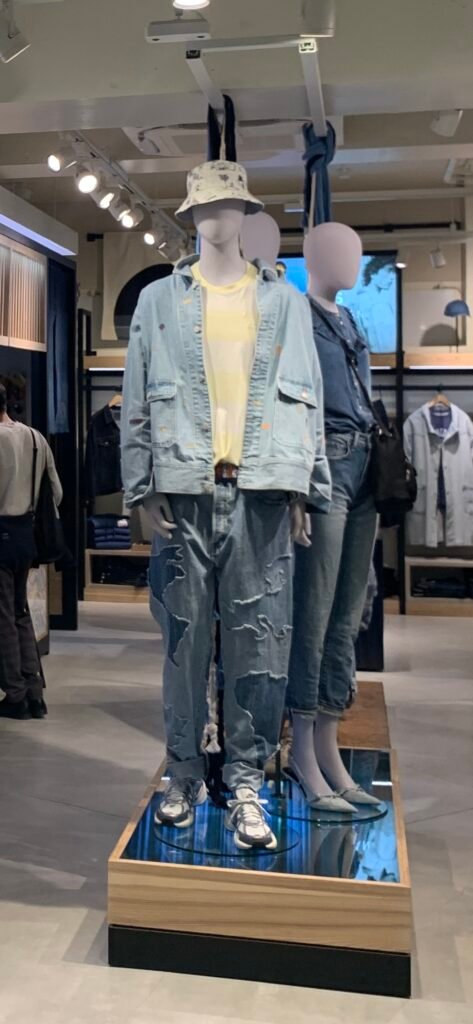
Marc-Tobias spotted these designery jeans on his travels in Japan. They are sort of must-have for map loving jeans wearers, you can buy them here
MapsintheWild Levis go Mappy
-
sur Warmer Stripes for 2023
Publié: 16 May 2024, 8:45am CEST par Keir Clarke
average global temperatures since 1850 Ed Hawkins' Warming Stripes visualization has now been updated to include 2023. Last year was the warmest year since accurate global records began. Globally the average temperature was 1.18°C (2.12°F) above the 20th-century average of 13.9°C (57.0°F). This means that your local warming stripes will probably now end with a very dark maroon colored stripe
-
sur Mappery: Missions of Mexico
Publié: 15 May 2024, 11:00am CEST
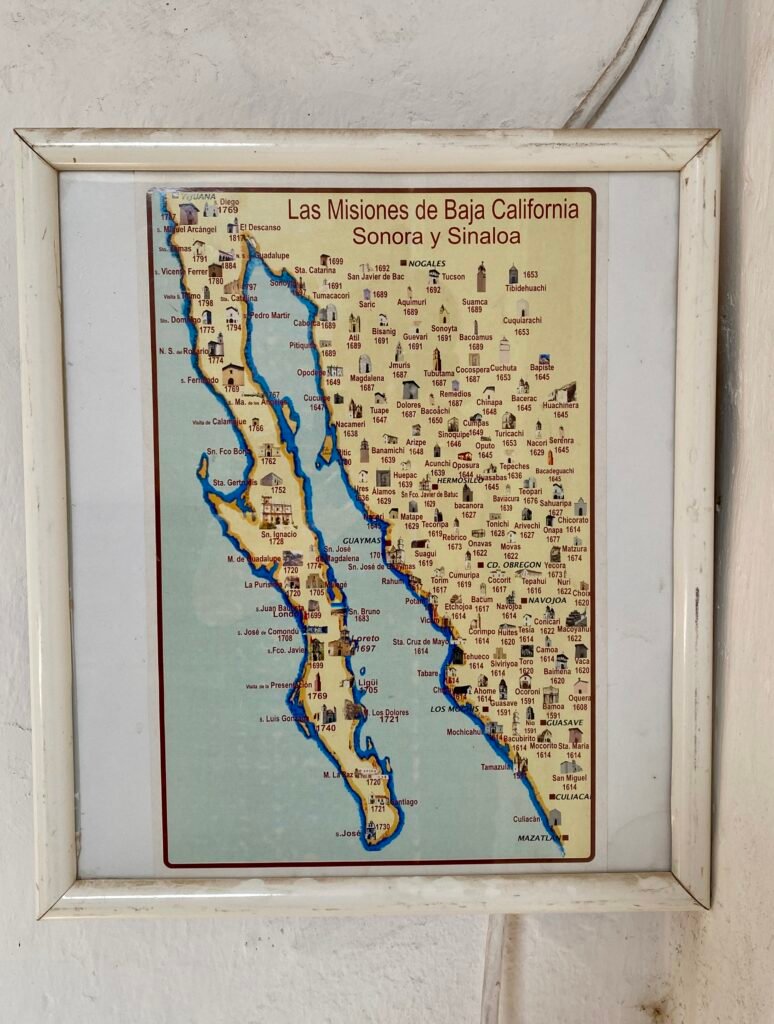
Walter Schwartz sentg us this, he said “Northwestern Mexico, where Baja, Sonora, and Sinaloa provinces are found, has been home to a *lot* of missions since at least 1591. I counted around 100 established in the 1600s and 1700s alone. This picto-map is in the pictured church, La Mision de San Ignacio in the town of San Ignacio, Baja California Sur, Mexico.
MapsintheWild Missions of Mexico
-
sur Is Europe Ready to Burn?
Publié: 15 May 2024, 9:17am CEST par Keir Clarke
This week Spanish news site El Diario wondered if Europe was ready for megafires. One of the most noticeable consequences of global heating over the last few years has been the increase in large wild fires across the world. In Megafires Burn Europe El Diario has mapped out all the wildfires in Europe this century which have burnt an area of more than 500 hectares. Two accompanying
-
sur GeoSolutions: GeoSolutions Presenting at UN Maps Conference 2024
Publié: 14 May 2024, 8:04pm CEST
You must be logged into the site to view this content.
-
sur Oslandia: (Fr) Direction de la Sûreté SNCF x accompagnement QGIS et QGIS Server
Publié: 14 May 2024, 3:21pm CEST
Sorry, this entry is only available in French.
-
sur Fernando Quadro: Geoprocessamento e IA no combate à dengue
Publié: 14 May 2024, 2:00pm CEST
Um software capaz de identificar, a partir de imagens aéreas, caixas d’água sobre telhados ou lajes e piscinas em áreas abertas foi desenvolvido por pesquisadores brasileiros com o auxílio de ferramentas de Inteligência Artificial. A proposta é usar esse tipo de imagem como indicador de zonas especialmente vulneráveis a infestações do mosquito Aedes aegypti, transmissor de doenças como dengue, zika e chikungunya. Além disso, a estratégia desponta como potencial alternativa para um mapeamento socioeconômico dinâmico das cidades – um ganho para diferentes políticas públicas.
A pesquisa, apoiada pela Fapesp, foi conduzida por profissionais da USP, da Universidade Federal de Minas Gerais (UFMG) e da Superintendência de Controle de Endemias (Sucen) da Secretaria de Estado da Saúde de São Paulo.
Entre outras coisas, o grupo almeja incorporar outros elementos para serem detectados nas imagens e quantificar as taxas reais de infestação do Aedes aegypti em uma dada região para refinar e validar o modelo. “Nós esperamos criar um fluxograma que possa ser aplicado em diferentes cidades para encontrar áreas de risco sem a necessidade de visitas domiciliares, prática que gasta muito tempo e dinheiro público”.
Apesar de as fotos aéreas de Campinas terem sido obtidas com um drone, espera-se que, no futuro, a estratégia testada nessa pesquisa recorra apenas às imagens de satélite.
No estudo em Belo Horizonte, as imagens de satélite foram empregadas com sucesso – elas precisam de alta resolução para que o computador consiga identificar os padrões.
Embora esse tipo de metodologia pareça custoso, ele gera uma potencial economia ao dispensar a necessidade de visitas presenciais para mapear, casa por casa, áreas suscetíveis à dengue. Em vez disso, os agentes de saúde aproveitariam as informações obtidas remotamente – e processadas com a Inteligência Artificial – para se dirigir aos locais prioritários com mais assertividade.
-
sur Mappery: Aerial Ping Pong
Publié: 14 May 2024, 11:00am CEST

Derick Rethams spotted this beer mat in his local pub in Maida Vale. For those of you who are interested
Southern Hemisphere IPA Northern Monk Collaboration. Motueka and Wai-Iti hops bring notes of lime, stone fruits and citrus, alongside a lofty dry hopping of Eclipse and Nectaron for a vibrant mix of orange, tropical fruit and a touch of pine to finish.
[https:]MapsintheWild Aerial Ping Pong
-
sur OGC announces Peter Rabley as new CEO
Publié: 14 May 2024, 10:45am CEST par Simon Chester
The Open Geospatial Consortium (OGC) is excited to announce the appointment of Peter Rabley as OGC’s Chief Executive Officer (CEO). The announcement was made last night at the Geospatial World Forum 2024 in Rotterdam, The Netherlands.
Peter brings to OGC a wealth of experience from the private, governmental, and not-for-profit sectors, including in venture financing, and in developing and implementing scale-up strategies for international not-for-profits.
“I am excited and honored to be appointed as OGC’s CEO,” said Peter Rabley. “OGC is well positioned to build on its incredible 30 year legacy by responding to the ever-increasing rate of change seen in technology and society alike. Opportunities and challenges have never been more apparent and I see tremendous potential for growth in new markets around the globe. This is the time of geospatial.”
“I am particularly excited to have Peter leading OGC,” commented Prashant Shukle, Chair of the OGC Board of Directors. “Peter has a proven track record in the public, private, and not-for-profit areas of the geospatial industry, and closely aligns with what our key stakeholders and partners were telling us they wanted in a CEO. The OGC Board took the time to get this selection right, and we are very excited about how Peter fits with our plans for a reinvigorated and repositioned OGC.”
Peter’s appointment to CEO is timely, with it coming during OGC’s 30th anniversary year—a time when OGC is taking stock of its successes while modernizing to respond to a global economy that increasingly uses geospatial technologies across so many domains and applications.
The OGC is one of the world’s largest data and technology consortia and one of its longest standing. Under Peter’s leadership, OGC will work with new and existing partners and stakeholders to bring accelerated, practical, and implementable solutions to our community.
About Peter Rabley
Peter Rabley is a technology executive, investor and geographer. He has spent the last thirty years creating and operating geospatial businesses that map the earth to improve lives and protect the resources of our planet. Prior to OGC, Peter Rabley co-founded PLACE, a non-profit data trust that makes mapping more accessible and affordable so that decision makers have the data they need to improve the places around them. At PLACE, Peter was responsible for strategy and managing the organization’s investment portfolio. Before PLACE, Peter was a venture partner at leading impact investing firm Omidyar Network, where he led the Property Rights initiative.
Peter has built various businesses including ILS, an enterprise software firm that provided property taxation, registration and mapping solutions to governments globally. After its acquisition by Thomson Reuters, he became Vice President for Global Business Development and Strategy at Thomson Reuters.
Peter remains on the board of PLACE. He also serves on the board of the Radiant Earth Foundation, Meridia, and Microbuild. He is a Fellow of the Royal Geographical Society and the Royal Society of Arts. Peter graduated from the University of Miami with a B.A. in Geography and Economics and an M.A. in Geography.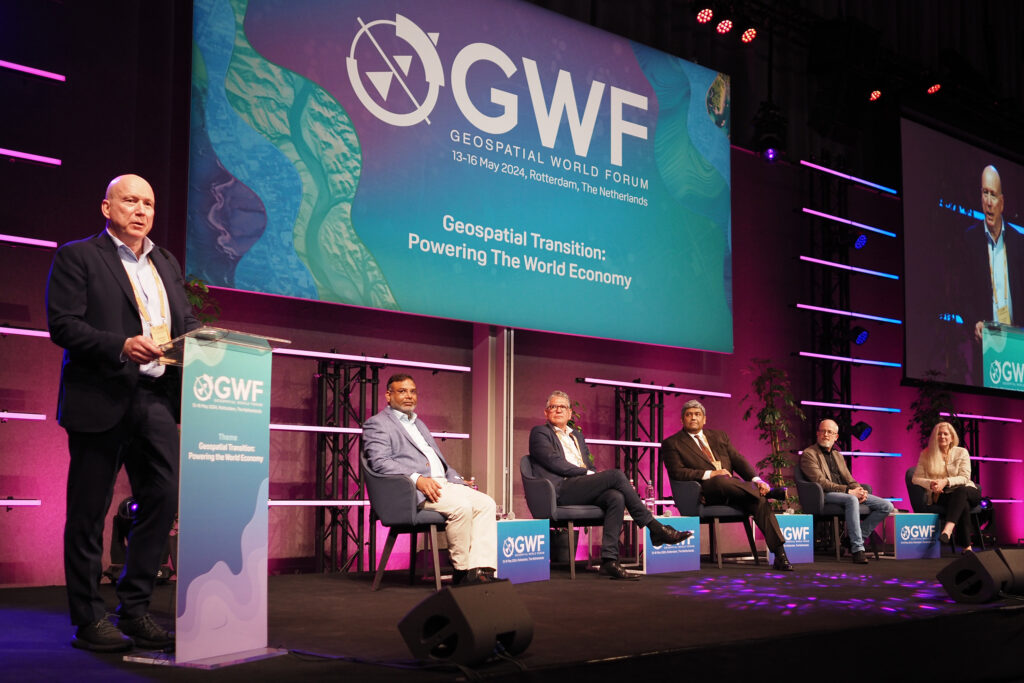 Peter Rabley (L) on stage at Geospatial World Forum 2024 with OGC Board Members (L-R) Zaffar Sadiq Mohamed-Ghouse, Rob van de Velde, Chair Prashant J. Shukle, Frank Suykens, and Deborah Davis.
Peter Rabley (L) on stage at Geospatial World Forum 2024 with OGC Board Members (L-R) Zaffar Sadiq Mohamed-Ghouse, Rob van de Velde, Chair Prashant J. Shukle, Frank Suykens, and Deborah Davis.The post OGC announces Peter Rabley as new CEO appeared first on Open Geospatial Consortium.
-
sur Welcome To Your New Gardening Zone
Publié: 14 May 2024, 10:44am CEST par Keir Clarke
In November of last year the US Department of Agriculture (USDA) updated the US plant hardiness map based on the latest weather data (1991–2020). The USDA Plant Hardiness Zone Map is a tool which is designed to help gardeners determine which plants are most likely to thrive in their location. The USDA map is divided into 13 zones based on average coldest temperatures. Zone 1 is
-
sur Mappery: Stanfords Discovered
Publié: 13 May 2024, 11:00am CEST

My friend Elizabeth just discovered Stanfords store in Covent Garden, she couldn’t resist sending me a pic but asking me “do you know about this place?” really?!?
This isn’t the first time we have featured Stanfords here but it really is the place of pilgrimage for map lovers visiting London.
MapsintheWild Stanfords Discovered
-
sur Can You Draw America?
Publié: 13 May 2024, 9:19am CEST par Keir Clarke
This morning I discovered that my geographical knowledge of the United States is ten times worse than I previously thought. Judging by my attempts to draw the outlines of all 50 states onto a blank map of the U.S. my application to the American Geographical Society is probably going to be summarily rejected.Regular readers of Maps Mania (yes both of you) may remember that in March I posted a
-
sur OPENGIS.ch: QGIS DXF Export enhancements
Publié: 13 May 2024, 6:48am CEST
At OPENGIS.CH, we’ve been working lately on improving the DXF Export QGIS functionality for the upcoming release 3.38. In the meantime, we’ve also added nice UX enhancements for making it easier and much more powerful to use!
Let’s see a short review.
DXF Export app dialog and processing algorithm harmonizedYou can use either the app dialog or the processing algorithm, both of them offer you equivalent functionality. They are now completely harmonized!
Export settings can now be exported to an XML fileYou can now have multiple settings per project available in XML, making it possible to reuse them in your workflows or share them with colleagues.
Load DXF settings from XML. All settings are now well remembered between dialog sessionsQGIS users told us there were some dialog options that were not remembered between QGIS sessions and had to be reconfigured each time. That’s no longer the case, making it easier to reuse previous choices.
“Output layer attribute” column is now always visible in the DXF Export layer treeWe’ve made sure that you won’t miss it anymore.
 Possibility to export only the current map selection
Possibility to export only the current map selection
Filter features to be exported via layer selection, and even combine this filter with the existing map extent one.

 Empty layers are no longer exported to DXF
Empty layers are no longer exported to DXF
When applying spatial filters like feature selection and map extent, you might end up with empty layers to be exported. Well, those won’t be exported anymore, producing cleaner DXF output files for you.
Possibility to override the export name of individual layersIt’s often the case where your layer names are not clean and tidy to be displayed. From now on, you can easily specify how your output DXF layers should be named, without altering your original project layers.
Override output layer names for DXF export.We’ve also fixed some minor UX bugs and annoyances that were present when exporting layers to DXF format, so that we can enjoy using it. Happy DXF exporting!
We would like to thank the Swiss QGIS user group for giving us the possibility to improve the important DXF part of QGIS



-
sur Paul Ramsey: Cancer 9
Publié: 13 May 2024, 2:00am CEST
Scanxiety.
This is where I am right now. Scanxiety.
Each stage of the cancer experience is marked by a particular set of tests, of scans.
I actually managed to get through my first set of scans surprisingly calmly. After getting diagnosed (“there’s some cancer in you”), they send you for “staging”, which is an MRI and CT scan.
These scans both involve large, Star Trek seeming machines, which make amazing noises, and in the case of the CT machine I was put through was decorated with colorful LED lights by the manufacturer (because it didn’t look whizzy enough to start with?).

I kind of internalized the initial “broad-brush” staging my GI gave me, which was that it was a tumor caught early so I would be early stage, so I didn’t worry. And it turned out, that was a good thing, since the scans didn’t contradict that story, and I didn’t worry.
The CT scan, though, did turn up a spot on my hip bone. “Oh, that might be a bone cancer, but it’s probably not.” Might be a bone cancer?!?!?
How do you figure out if you have “a bone cancer, but it’s probably not”? Another cool scan, a nuclear scan, involving being injected with radioactive dye (frankly, the coolest scan I have had so far) and run through another futuristic machine.

This time, I really sweated out the week between the scan being done and the radiology coming back. And… not bone cancer, as predicted. But a really tense week.
And now I’m in another of those periods. The result of my major surgery is twofold: the piece of me that hosted my original tumor is now no longer inside of me; and, the lymph nodes surrounding that piece are also outside of me.
They are both in the hands of a pathologist, who is going to tell me if there is cancer in the lymph nodes, and thus if I need even more super unpleasant attention from the medical system in the form of several courses of chemotherapy.
The potential long term side effects of the chemotherapy drugs used for colorectal cancers include permanent “peripheral neuropathy”, AKA numbness in the fingers and toes. Which could put a real crimp in my climbing and piano hobbies.
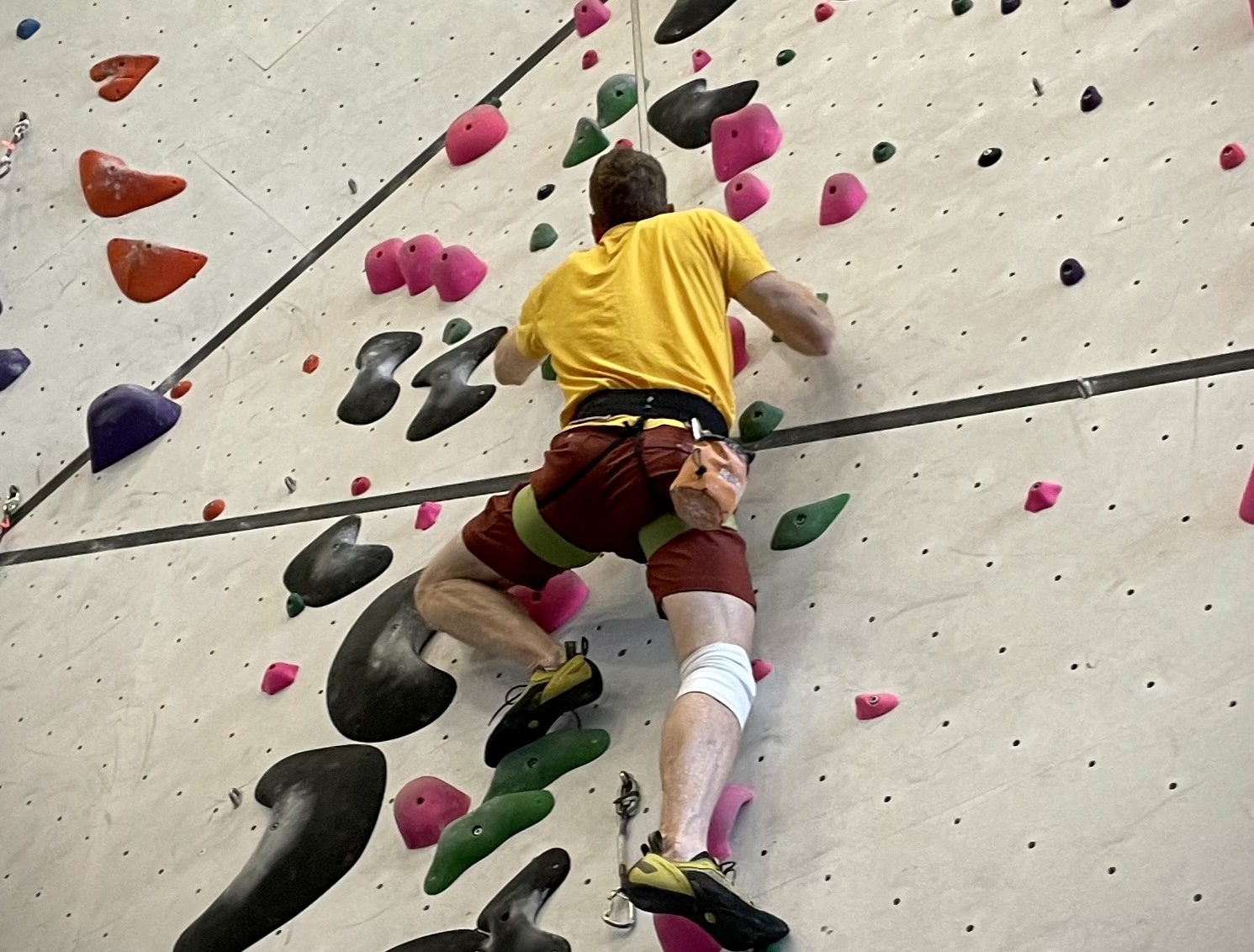
So as we get closer to getting that report, I am experiencing more and more scanxiety.
If I escape chemo, I will instead join the cohort of “no evidence of disease” (NED) patients. Not quite cured, but on a regular diet of blood work, scans, and colonoscopy, each one of which will involve another trip to scanxiety town. Because “it has come back” starts as a pretty decent probability, and takes several years to diminish to something safely unlikely.
Yet another way that cancer is a psychological experience as well as a physical one.
Talk to you again soon, inshalla.
-
sur Mappery: Ortelius and his Globe
Publié: 12 May 2024, 11:00am CEST
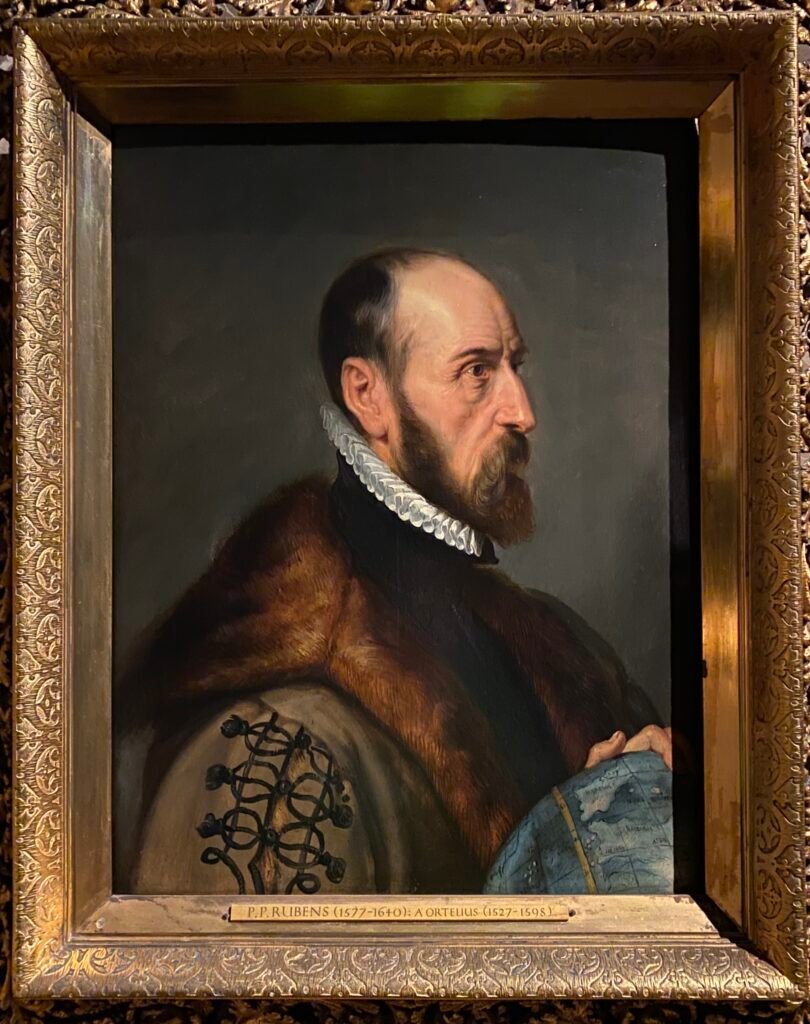
Reinder shared this pic of Ortelius and his globe by Rubens from his visit to the Plantin-Moretus museum in Antwerp, Belgium.
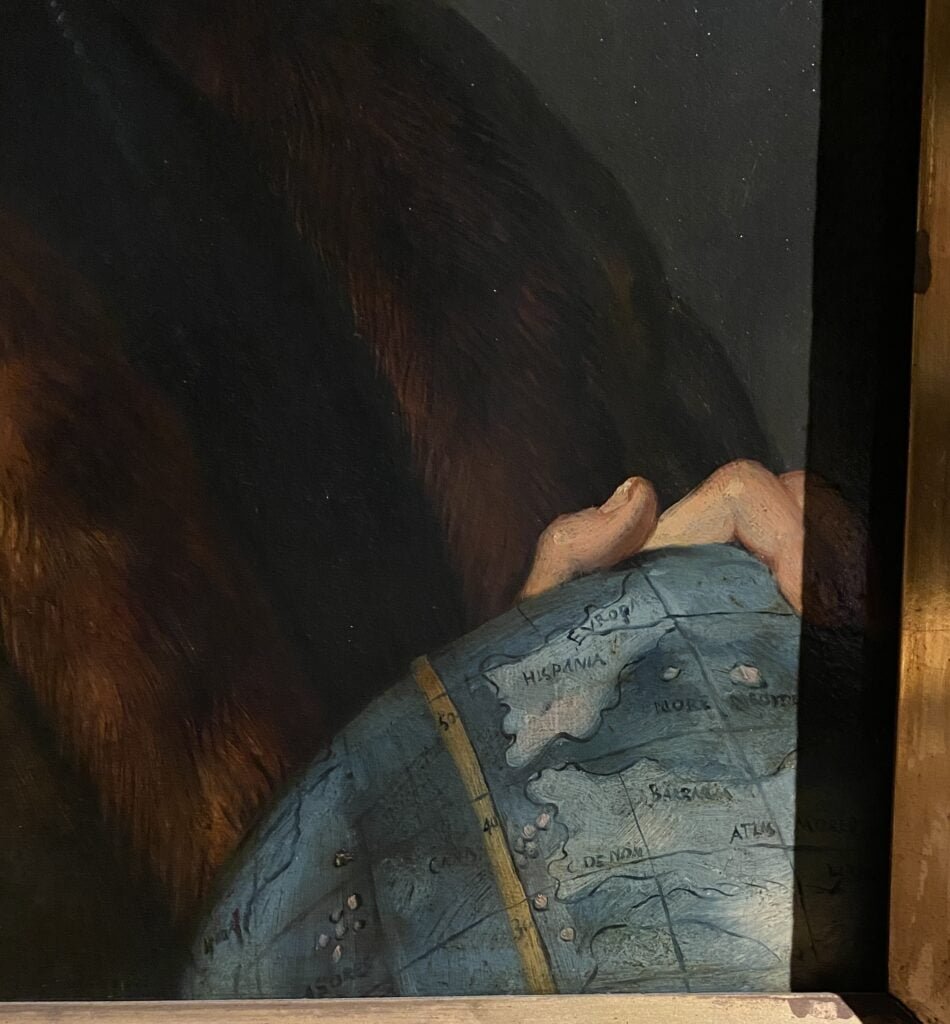
Nice detail
MapsintheWild Ortelius and his Globe
-
sur Mappery: One World cafe, and more
Publié: 11 May 2024, 12:00pm CEST
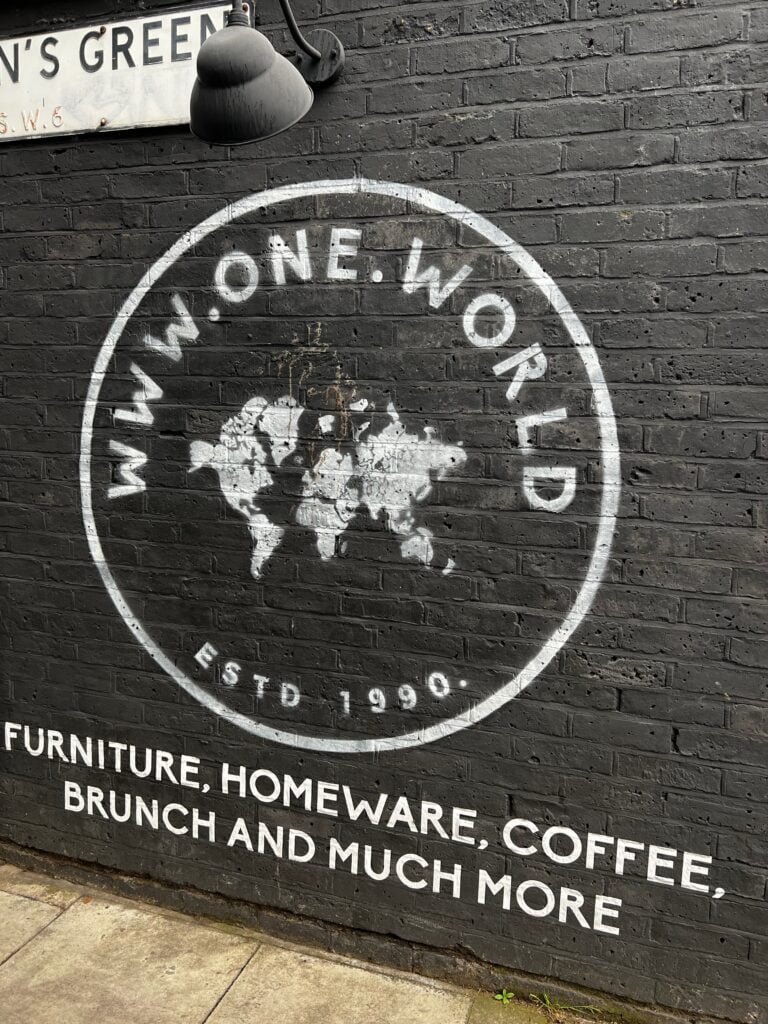



Walking around Parson Green, I discovered this cafe and wine bar, which also sells furniture and cookware. It was too late on a Sunday evening to try it. And the extensive use of the world maps without missing Madagascar and New Zealand is worth a post.
MapsintheWild One World cafe, and more
-
sur Active Video
Publié: 11 May 2024, 9:52am CEST par Keir Clarke
Glen Chiacchier has devised an interactive mapped, timeline for the American civil rights documentary Eyes on the Prize. His 'active video' of Eyes on the Prize turns what might otherwise be a passive viewing exercise into an active learning experience by providing viewers with the opportunity to browse the documentary by date and location. The civil rights documentary Eyes on the Prize
-
sur Alexandre Neto: Create a PyQGIS Development Environment Using Conda and VScode
Publié: 11 May 2024, 3:32am CEST
As a self-taught PyQGIS developer, one of my main hurdles has always been to prepare the development environment for PyQGIS. An environment that allow me to run PyQGIS scripts, helps me code faster by providing PyQGIS highlighting and autocompletion, enables me to debug my plugins and scripts as they run, etc… I have been a user (and even a… “cof cof”… maintainer) of the QGIS packages for conda provided by the conda-forge community. -
sur GeoSolutions: GeoSolutions Presenting at Geospatial World Forum 2024
Publié: 10 May 2024, 6:46pm CEST
You must be logged into the site to view this content.
-
sur Mappery: David Hockney Immersive experience
Publié: 10 May 2024, 12:00pm CEST
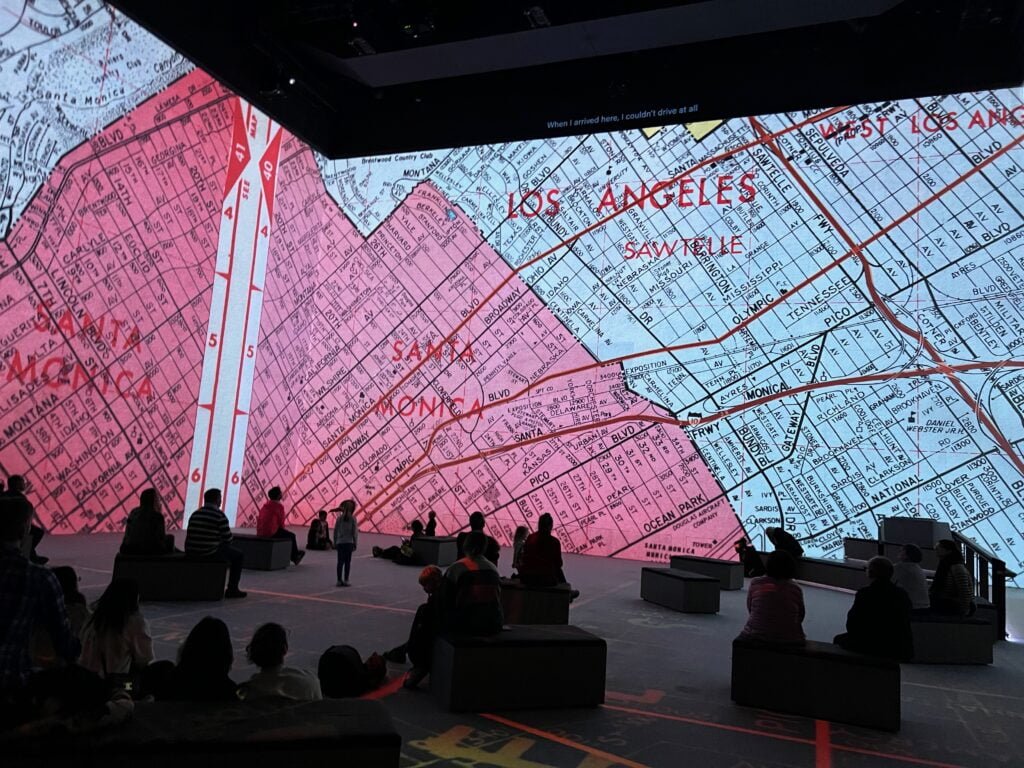
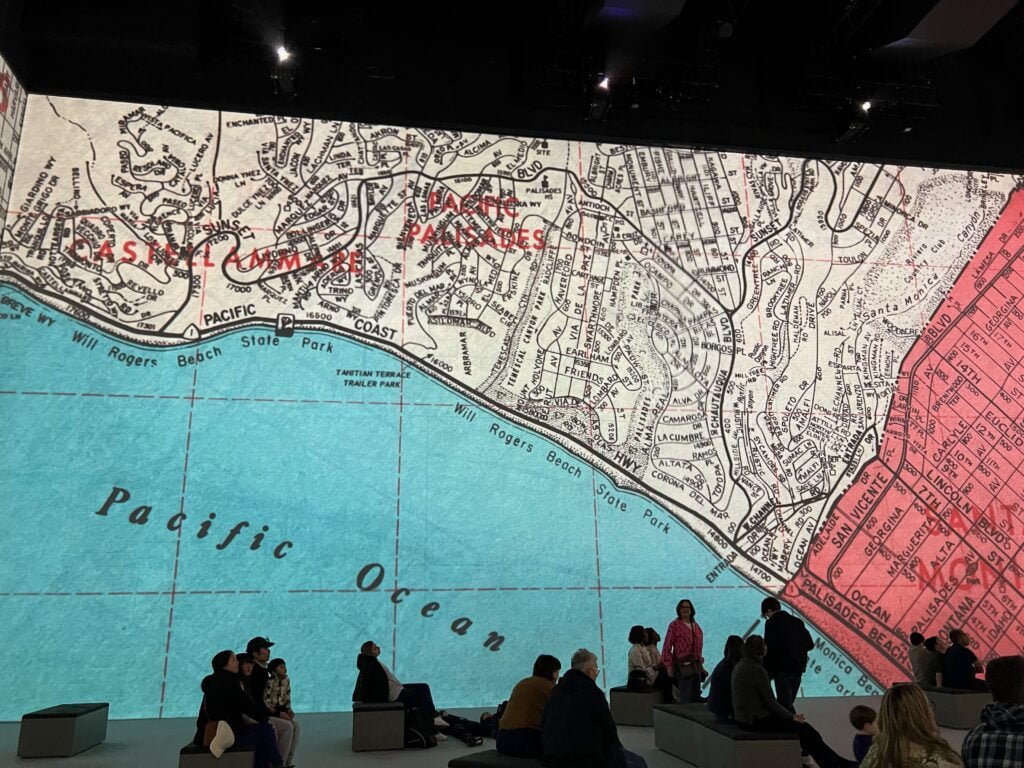
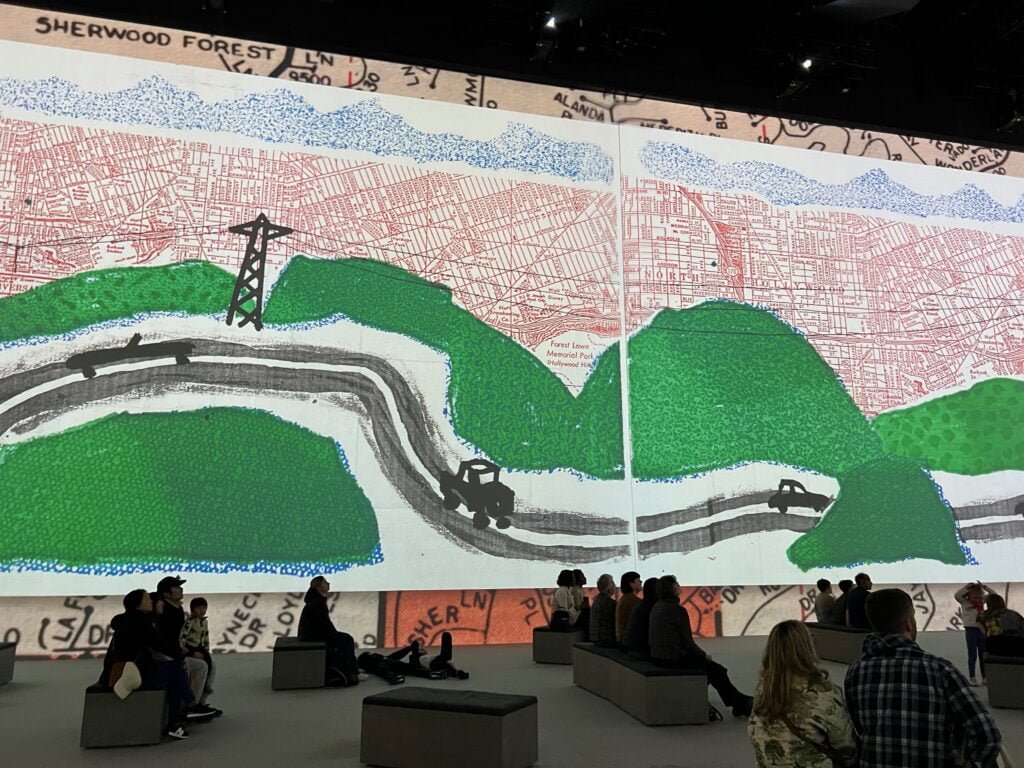


These shots were taken at Lightroom, London’s David Hockney immersive experience.
The show comes back on 17 June 2024.
MapsintheWild David Hockney Immersive experience
-
sur The Secret Life of Bridges
Publié: 10 May 2024, 9:57am CEST par Keir Clarke
This amazing animated map visualization shows the cumulative growth of bridges in the U.S. since 1800. The map reveals the development of mass transport over the last two centuries and the enormous role that bridges play in the U.S. economy. The animation is just one of a number of impressive mapped visualizations in Esri's Secret Life of Bridges. The Secret Life of Bridges is an Esri story-map -
sur Virtual Road Trips
Publié: 9 May 2024, 9:46am CEST par Keir Clarke
This summer why not go on that huge cross-country road-trip that you've always dreamed of undertaking? The great American Road Trip is a call to freedom. It is a chance to craft your own adventure while witnessing the vast beauty and the diversity of landscapes that America has to offer. Whether you crave the thrill of the Pacific Coast Highway or the charm of Route 66, a road-trip promises -
sur The Future of Street View
Publié: 8 May 2024, 3:41pm CEST par Keir Clarke
In 2007 Google began adding 360 degree panoramic images to Google Maps. It is no exaggeration to say that the introduction of Street View revolutionized online mapping. Now users could not only zoom into their neighborhoods in satellite view but they could also virtually explore their area in Street View.It is almost impossible to predict the next major revolution in online mapping. For a -
sur Hexagen World
Publié: 6 May 2024, 9:00am CEST par Keir Clarke
Hexagen World is a game world generated by players using AI prompts. The game is similar to the popular r/Place project. However in Hexagen World instead of users adding one pixel to a collaborative image they can add AI generated hexagon tiles to a world map.Register with Hexagen World and you can add your own hexagons to the map. Just click on a blank hexagon and enter an AI prompt to -
sur 540 Million Years of Planet Earth
Publié: 4 May 2024, 11:48am CEST par Keir Clarke
540 million years ago the Earth's climate was very different from how it is today. During the Cambrian period global temperatures were warmer than they are now. It is believed there were no polar icecaps and there was likely to have been high levels of precipitation and humidity over much of the planet. Of course our world hasn't always been so warm. The last Ice Age was during the -
sur The 2024 World Press Freedom Rankings
Publié: 3 May 2024, 10:01am CEST par Keir Clarke
Reporters Without Borders (RSF) has released its annual World Press Freedom Index report. The 2024 report analyses and maps the levels of press freedom in countries around the world. The map ranks the level of press freedom in countries based on five different indicators. Norway, Denmark and Sweden respectively lead the 2024 rankings. The United States has fallen to 55th overall. Once seen as a -
sur Whose Plaque is it Anyway?
Publié: 2 May 2024, 11:48am CEST par Keir Clarke
For over 20 years I've wondered what the text on this plaque in East London actually says. This morning I finally decided to explore a few memorial interactive maps to see if I could discover why this bridge over Bow Creek has a plaque, and what the text on the plaque actually says. I thought it might also be a good opportunity to provide a little round-up of the growing number of memorial -
sur The Global Inflation Tracker
Publié: 1 May 2024, 10:08am CEST par Keir Clarke
The Council on Foreign Relations new Global Inflation Tracker provides an intriguing guide to trends in prices across the world since the 1990s. On the map almost 200 countries around the world are colored to show their year-over-year rate of inflation (the darker the color the higher the rate of inflation).If you animate through the data on the map it is striking how stable inflation rates in -
sur Live From Space
Publié: 30 April 2024, 9:49am CEST par Keir Clarke
The 3D ISS Tracker shows the position of the International Space Station above the Earth in real-time. It also shows a stunning live HD view of Earth as seen and broadcast from the ISS. The position of the ISS is indicated by the little yellow dot slowly circling the Earth If you zoom out on the globe you can also view the current positions of the sun and moon. The cloud layer shown on -
sur Weather or Not
Publié: 29 April 2024, 8:37am CEST par Keir Clarke
Do you dream of the perfect vacation weather? Sunshine on the beach, crisp mountain air, or vibrant fall foliage? Imagine a tool that helps you find the ideal destination for your desired climate, anywhere in the country and for any month of the year. This is the promise of Weather or Not, a new interactive map that leverages average weather data to recommend the best time to travel -
sur The US Heat Risk Map
Publié: 27 April 2024, 10:53am CEST par Keir Clarke
A new interactive map has been released to help warn Americans of extreme temperatures. The new HeatRisk map provides a weekly forecast of the lower 48 states showing where temperatures may be high enough to harm people's health.On the HeatRisk map areas are colored to show the forecast risks of extreme heat, using a color ramp that proceeds from green (little or no risk) to magenta (rare and/
-
sur Mappery: Cookie Cutter (literally)
Publié: 19 April 2024, 11:00am CEST
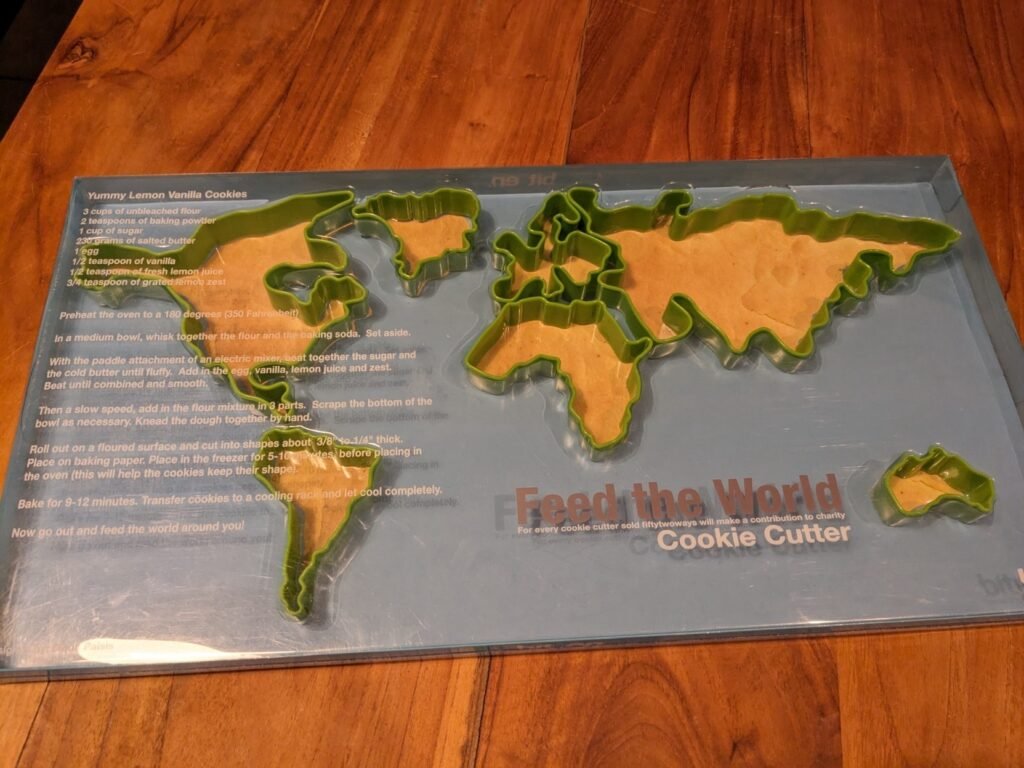
Erik spotted this in a thrift shop.
“Best thrift store find of the year: #MapsintheWild cookie cutter (or: clip irl function). I’ll accept the #mapswithoutnewzealand issue. Wouldn’t be more than a crumb anyway!”
MapsintheWild Cookie Cutter (literally)
-
sur ? of Rafah’s Buildings Destroyed
Publié: 19 April 2024, 7:18am CEST par Keir Clarke
Bloomberg has analysed satellite imagery of the Palestinian city of Rafah and determined that Israel has damaged or destroyed about 32% of the region's buildings.In How the Israel-Hamas War has Reshaped Rafah in Gaza Bloomberg presents a satellite image of the Palestinian city. As you scroll through the article a layer is superimposed on top of this satellite view to show buildings which have
-
sur Mappery: Arab Islands in Reflection
Publié: 18 April 2024, 11:00am CEST
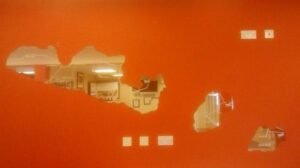
Stan Carey shared this mirror map.
“Mirrors in the shape of the Aran Islands at Connemara Airport, alongside Tim Robinson’s map for lo-fi comparison (below)”

MapsintheWild Arab Islands in Reflection
-
sur The American Home Values Map
Publié: 18 April 2024, 9:04am CEST par Keir Clarke
Home Values in America is a dot density map showing the self-reported value of homes across the whole United States.The map shows home values across the United States using data from the U.S. Census Bureau's 2018-2022 American Community Survey (ACS). The ACS is a large-scale survey that gathers information about the American population every year.The colored dots on the map
-
sur Paul Ramsey: Cancer 4
Publié: 18 April 2024, 2:00am CEST
Cancer is a mind fuck.
I mean, it’s a body fuck too, obviously, but the early experience for me has been of weird gyrations of mental health and mood with each passing day.
The first thing I did was the first thing everyone does – look up all the different probabilities of five year survival, because that’s what is at the top of the Google search.
With a stage two diagnosis (hard to know if that’s actually what I have, though) Google says I have a 10% chance of dying over the next five years.
That feels like… a lot? A scary amount.

But wait, here’s an fact – my odds of dying just in the ordinary course of affairs over the next five years are about 4.5%.
Does that stop me from being 1000% more terrified, on a daily basis, since receiving my diagnosis? No it does not.
A good deal of that terror, I think, is that cancer promises a patient a long and painful interaction with a medical system that has only destructive rear-guard actions at hand to stop it. Cut things out; kill it with poison; zap it with radiation. These procedures all leave a body worse for wear, and if they don’t work… they bring you back and do some more of them.
My great grandfather died while rolling a ball on the lawn bowling green in his late 80s. Massive stroke, he died doing something he loved and was dead before he hit the ground. Floyd Ramsey hit the mortality jackpot.
Naturally, I would also like to hit that jackpot. Cancer says, “not so fast, you might have a different life experience ahead of you”.
It would be a little too pat to say that getting a diagnosis starts you off on the stages of grief, because that implies some orderly process to the mental evolution. I am not progressing linearly through the stages of grief, so much as visiting them randomly, over and over, in an emotional shuffle mode.
Some days are denial days. Some days are acceptance days. Some days are bargaining days.

I told my councillor last week that “I only feel OK to the extent that I am dissociative”, and that seems to still hold true. I am at my most together when I have fully distracted myself from the diagnosis. I’m not sure if this counts as “taking one day at a time”. Probably not.
Talk to you again soon, on the other side, inshalla.
-
sur A recap of the 128th OGC Member Meeting, Delft, The Netherlands
Publié: 17 April 2024, 11:32pm CEST par Simon Chester
Two records were broken in Delft this March: not only was OGC’s 128th Member Meeting our biggest ever – with over 300 representatives from industry, government, and academia attending in-person (and over 100 virtual) – but the meeting also saw a record number of motions for votes on new Standards, highlighting the very productive activities undertaken by the OGC community in recent months.
Held in Delft, Netherlands from 25-28 March, 2024, OGC’s 128th Member Meeting brought together global standards leaders and geospatial experts looking to learn about the latest happenings at OGC, advance geospatial standards, and see what’s coming next. Hosted by TU Delft and sponsored by Geonovum with support from GeoCat and digiGO, the overarching theme for the meeting was GeoBIM for the Built Environment.
As well as the many Standards and Domain Working Group meetings, the 128th Member Meeting also included a Land Administration Special Session, a Geospatial Reporting Indicators ad hoc, a Data Requirements ad hoc, the OGC Europe Forum, an Observational Data Special Session, two Built Environment sessions subtitled The Future of LandInfra and What Urban Digital Twins Mean to OGC, a public GeoBIM Summit, a Quantum Computing ad hoc, and the usual Monday evening reception & networking session and Wednesday night dinner.
The dinner was held at the historic Museum Prinsenhof Delft, former residence of William of Orange, and – grimly – where he was assassinated. On a lighter note, during the dinner Ecere Corporation, represented by Jérôme Jacovella-St-Louis, received an OGC Community Impact Award for their tireless work in driving OGC Standards forward. Congratulations Ecere and Jérôme!
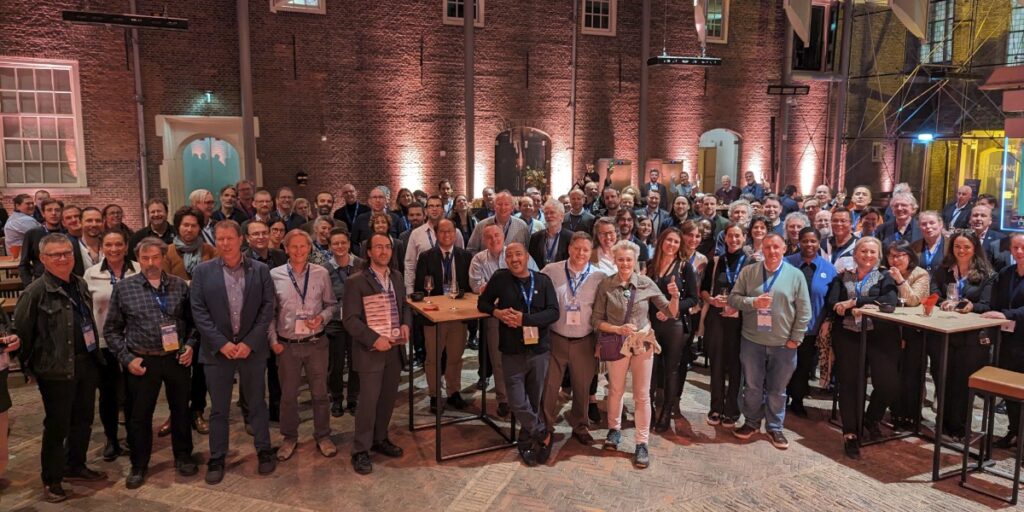 Attendees of the Wednesday night dinner at OGC’s 128th Member Meeting.
Attendees of the Wednesday night dinner at OGC’s 128th Member Meeting.
Also during the meeting members of the OGC GeoPose and POI SWGs in collaboration with the Open AR Cloud team and XR Masters, and support from Geonovum demonstrated interoperable AR browsers. The two AR browsers (one native app, MyGeoVerse by XR Masters, and spARcl, a WebXR-based browser) were able to share/see the same POIs while being geolocalized using the Augmented City Visual Positioning Service (VPS). The VPS receives requests from (and returns) ‘GeoPoses’ to any OGC-compliant app that has implemented the GeoPose standard. The project details are described on this page and captured in this two minute video on YouTube.
In tandem with the theme of GeoBIM, two other technology areas stood out during the meetings: Data Spaces, and the transition from OGC Web Services to OGC APIs.
Data SpacesThere has lately been a dramatic increase in the number of discussions on Data Spaces, both in and outside of OGC, as the concept becomes more commonplace in European projects and policy. As per the European Union Data Spaces Support Centre, a Data Space is defined as “an infrastructure that enables data transactions between different data ecosystem parties based on the governance framework of that data space.” In other words, the “space” in a Data Space defines a context for which the data are useful: a container, governance, and access. Given the ubiquitous use of geospatial data, directly and indirectly, an understanding of the Data Space ecosystem may be key to participate in emerging data infrastructures.
OGC Web Services to OGC API transitionThe full set of capabilities offered by the OGC Web Services Standards (e.g., Web Map Service (WMS), Web Feature Service (WFS), etc.) is now reflected in OGC API Standards that have either been published, are approaching final approval vote, or are being actively developed. Over the coming months, OGC will establish a process and resources to aid in the transition to the more modern Standards, while ensuring that the user community recognizes that the legacy web services are still functional and valuable.
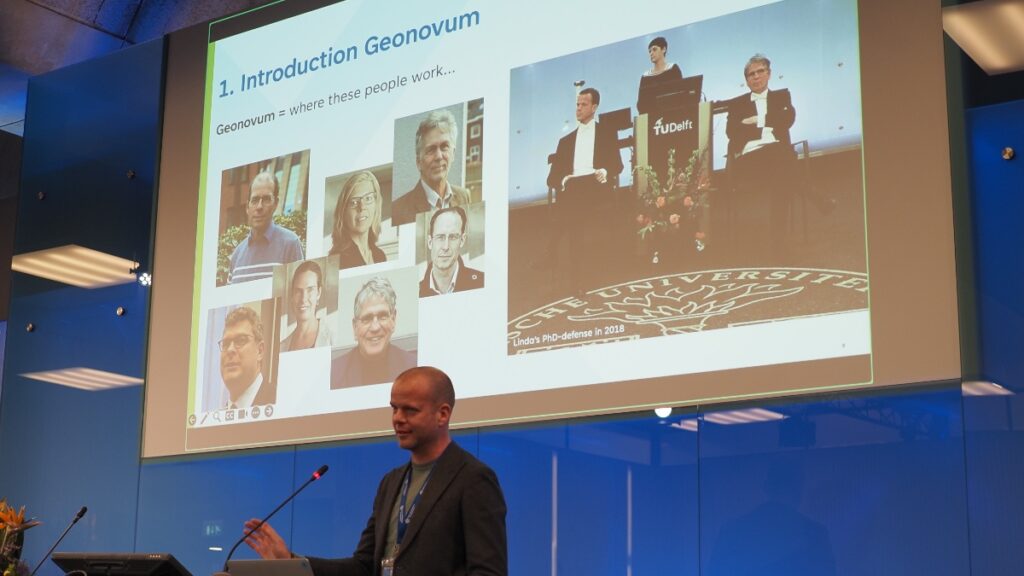 Friso Penninga, CEO of Geonovum, opens the week with an introduction to Geonoum and Delft.
Opening Session
Friso Penninga, CEO of Geonovum, opens the week with an introduction to Geonoum and Delft.
Opening Session
The week opened with a welcome from Friso Penninga, CEO of Geonovum, who outlined not only the work of Geonovum, but also the culture of Delft. Following this, Prof. Jantien Stoter of 3Dgeoinfo, TU Delft highlighted activities at TU Delft in the meeting theme area and previewed Wednesday’s GeoBIM Summit. Pieter van Teeffelen of digiGO then presented a Dutch platform for digital collaboration in the built environment. Finally, Jeroen Ticheler of GeoCat explained challenges in social welfare and the work of the GeoNetwork to address these challenges.
Next, it was time to settle a long-running dispute in OGC: who has the better chocolate, Switzerland or Belgium? After a blind taste-test, the audience voted Belgium as the winner. Is the debate now settled? Only time – and perhaps our taste buds – shall tell.
The chocolate contest was followed by a demonstration of the Netherlands Publieke Dienstverlening Op de Kaart (PDOK) geodata platform, which integrates a number of published and draft OGC API Standards.
Special tribute was then paid to two instrumental figures in OGC’s history who passed away in November 2023: Jeff de la Beaujardiere (OGC Gardels and Lifetime Achievement Awards recipient) and Jeff Burnett (former OGC Chief Financial Officer).
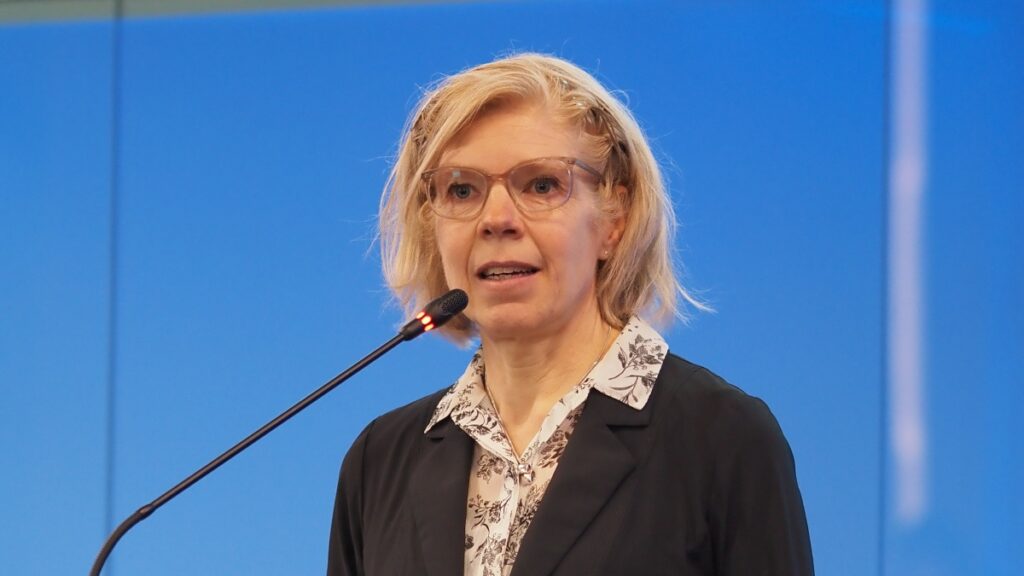 Prof. Jantien Stoter of 3Dgeoinfo, TU Delft, offered a preview of Wednesday’s GeoBim Summit during the Opening Session.
Today’s Innovation, Tomorrow’s Technology, and Future Directions
Prof. Jantien Stoter of 3Dgeoinfo, TU Delft, offered a preview of Wednesday’s GeoBim Summit during the Opening Session.
Today’s Innovation, Tomorrow’s Technology, and Future Directions
As always, the popular Today’s Innovation, Tomorrow’s Technology, and Future Directions session runs unopposed on the schedule so that all meeting participants can attend. At this Member Meeting, the session was presented by Marie-Françoise Voidrot and Piotr Zaborowski of OGC’s Collaborative Solutions and Innovation Program (COSI). The session focused on several projects that OGC is participating in and are developing capabilities that will be of use to all members. Many of these projects are sponsored by the European Union to advance interoperable science and data management and are supporting OGC resources such as the OGC RAINBOW registry, GeoBIM integration, and learning and developer resources, such as the Location Innovation Academy.
OGC Members can access the presentations and a recording from the session on this page in the OGC Portal. An overview of some of the European projects highlighted during the session, entitled European Innovation, Global Impact, was published on the OGC Blog last year.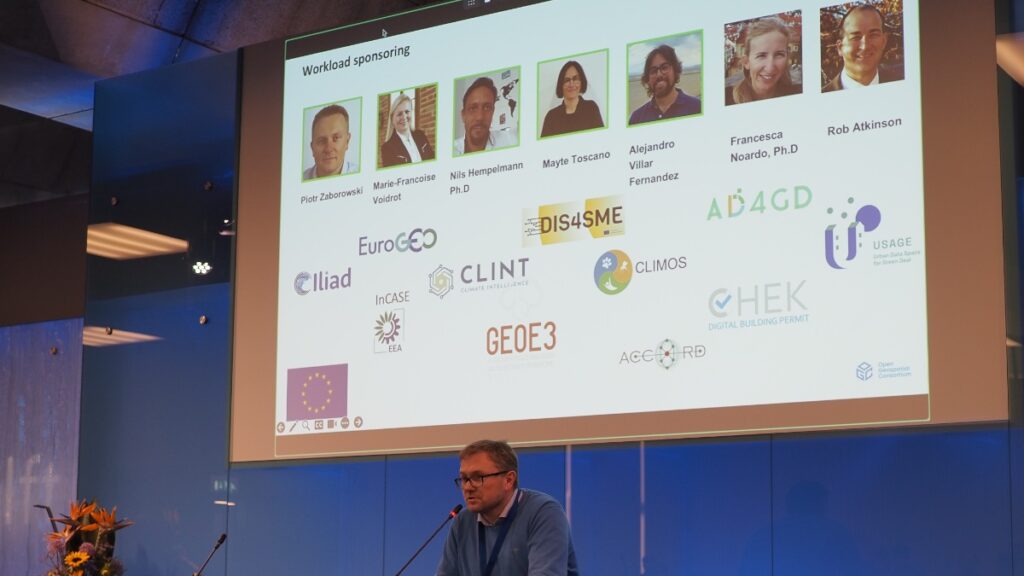 Piotr Zaborowski, Senior Director, of OGC’s Collaborative Solutions and Innovation Program, presents some of the European Union funded projects in which OGC is involved.
Meeting Special Sessions
Piotr Zaborowski, Senior Director, of OGC’s Collaborative Solutions and Innovation Program, presents some of the European Union funded projects in which OGC is involved.
Meeting Special Sessions
The Land Administration Special Session was dedicated to updating OGC membership on the progress of Land Administration activities amongst members and in ISO/TC 211, where the Land Administration Domain Model (LADM) is managed. A new Land Administration Domain Model Standards Working Group (SWG) is being considered to create Part 6 of LADM: the encoding of Parts 1-5 in one or more formats. OGC Members can access the presentations and a recording here (Session 1) and here (Session 2) in the OGC Portal.
Geospatial Reporting Indicators have been discussed in the OGC Climate Resilience Domain Working Group (DWG) in the context of Land Degradation. However, the means to exchange indicator information reporting the degree of land degradation (or influencing factors) is not standardized in the community. OGC members are therefore proposing a new SWG to develop such standardized reporting indicators, possibly as extended functionality of work in Analysis Ready Data (ARD). OGC Members can access the presentations and a recording on this page in the OGC Portal.
An ad hoc session on Geospatial Data Requirements was held to assess the chartering of a new SWG. The purpose of this proposed SWG is to develop a Standard for describing what geospatial data a project or task needs to collect, store, analyze, and present to achieve the project objectives. OGC Members can access the presentations and a recording on this page in the OGC Portal.
The OGC Europe Forum met on Tuesday with presentations focused on Data Spaces: understanding the European Commission principles of data spaces and how OGC members can engage in the topic. The Forum featured speakers from the International Data Spaces Association (IDSA), ISO/TC211, and the European Commission’s Joint Research Centre (JRC) as well as an open panel discussion. OGC Members can access the presentations and a recording on this page in the OGC Portal.
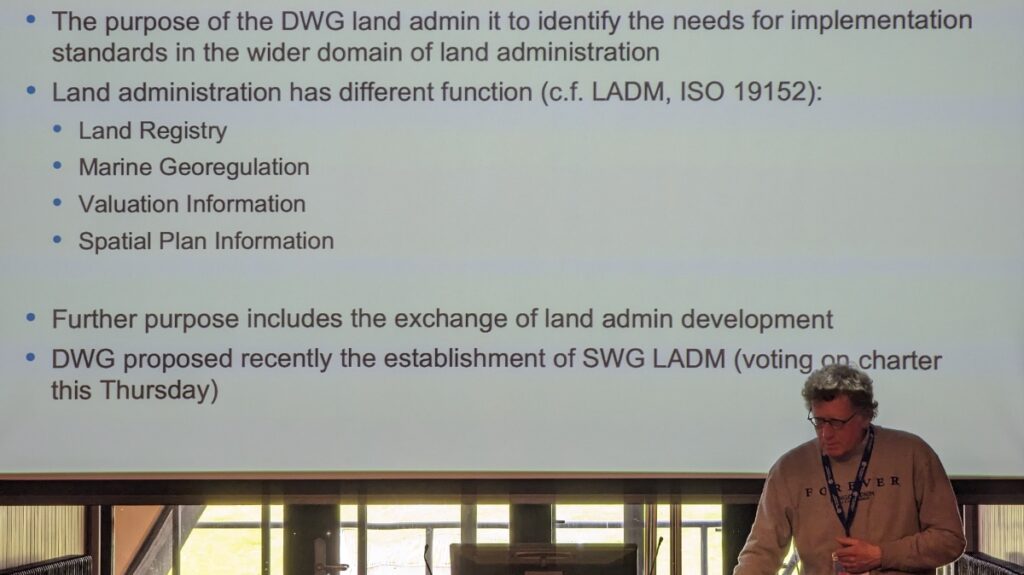 Peter van Oosterom, from TU Delft and the co-chair of the OGC Land Administration DWG, presents during the Land Administration Special Session.
Peter van Oosterom, from TU Delft and the co-chair of the OGC Land Administration DWG, presents during the Land Administration Special Session.
The Observational Data Special Session was organized to identify the various OGC Working Groups that are building Standards or assessing the collection & use of observational data. The session clarified the commonalities between these WGs so they can be considered in future development of observational data Standards. OGC Members can access the presentations and a recording on this page in the OGC Portal.
Two sessions were held to discuss and prioritize the next steps for OGC activities concerning standardization in the Built Environment. The first of these sessions focused on the future development of the LandInfra suite of Standards: whether priority should be made on new encodings, new Parts, or other tasks. OGC Members can access the presentations and a recording on this page in the OGC Portal.
The second Built Environment session considered the topic of what Urban Digital Twins mean to OGC. Presentations on human engagement as sensors and the place for digital twins in data spaces were followed by a preview of the OGC Urban Digital Twins Discussion Paper and a panel of OGC specialists to discuss where Urban Digital Twins are most important in OGC. OGC Members can access the presentations and a recording on this page in the OGC Portal.
The public GeoBIM Summit emphasized the theme of this meeting: there is a great amount of continuity between the geospatial and Building Information Modeling (BIM) communities and their respective technologies and practices. Numerous rapid presentations highlighted activities using OGC and BIM Standards and use-cases for interoperability. OGC Members can access the presentations and a recording on this page in the OGC Portal. Presentations and recordings will soon be made available to the public on the GeoBIM Summit event page.
The Quantum Computing ad hoc session included open discussion from OGC Members working with or researching the application of quantum computing technology on geospatial issues. Future ad hoc meetings are planned to move towards the development of an OGC Quantum Computing Working Group.
Closing PlenaryThe Closing Plenary normally includes two sessions: an open discussion of Important Things suggested by members, followed by motions, votes, and presentations from members to advance the work of the Consortium. However, with the Member Meeting being compressed down to four days (as Friday was a regional holiday) the Important Things discussion was not held. As such, I opened the Closing Plenary with a rapid, 7-minute summary of the entire meeting week, which included Slides and content from a large number of the week’s Working Group sessions, available to OGC Members on this page in the OGC Portal. The Closing Plenary included a record number of motions for votes on new Standards, highlighting the very productive activities of OGC members in recent months.
Thank youOur 128th Member Meeting was our biggest yet. As always, it’s a pleasure to see hundreds of OGC Members get together to discuss, collaborate, and drive technology and standards development forward. Once again, a sincere thank you to our members for investing their time and energy, as well as their dedication to making OGC the world’s leading and most comprehensive community of location experts.
Be sure to join us at Centre Mont-Royal in Montreal, Canada, June 17-21, 2024, for our 129th Member Meeting. Registration is open now on ogcmeet.org. Sponsorship opportunities remain available – contact OGC for more info.
To receive a digest of the latest OGC news in your inbox every two weeks, be sure to subscribe to the OGC Newsletter.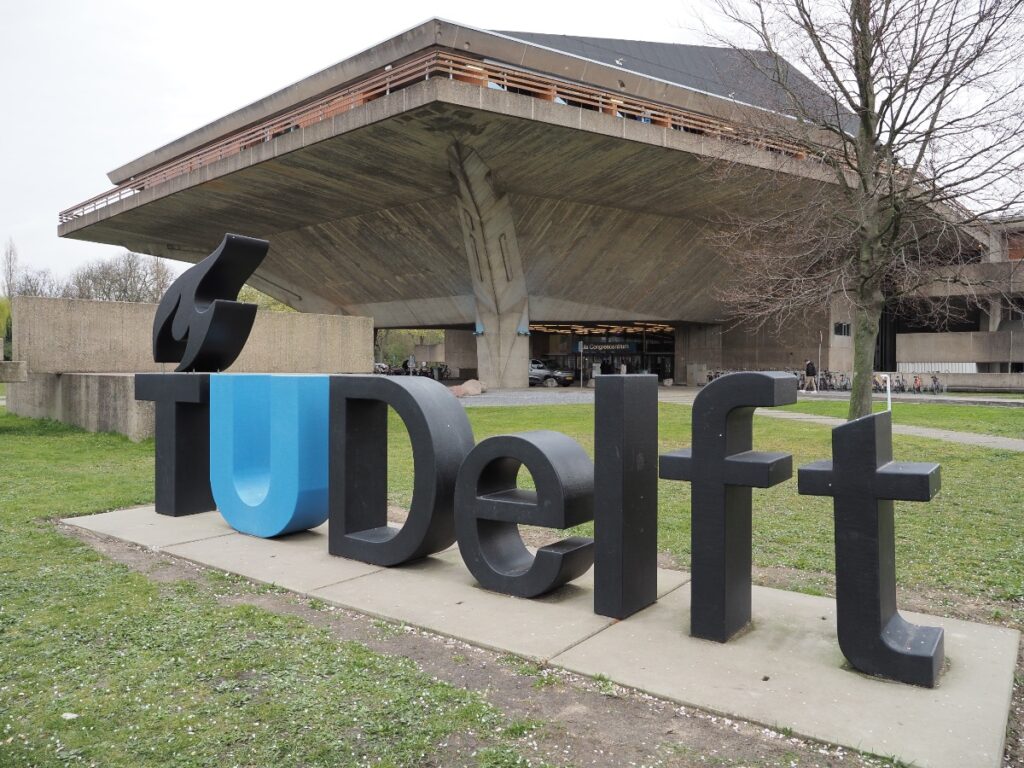
The post A recap of the 128th OGC Member Meeting, Delft, The Netherlands appeared first on Open Geospatial Consortium.
-
sur Mappery: Floor Puzzle Map
Publié: 17 April 2024, 11:00am CEST
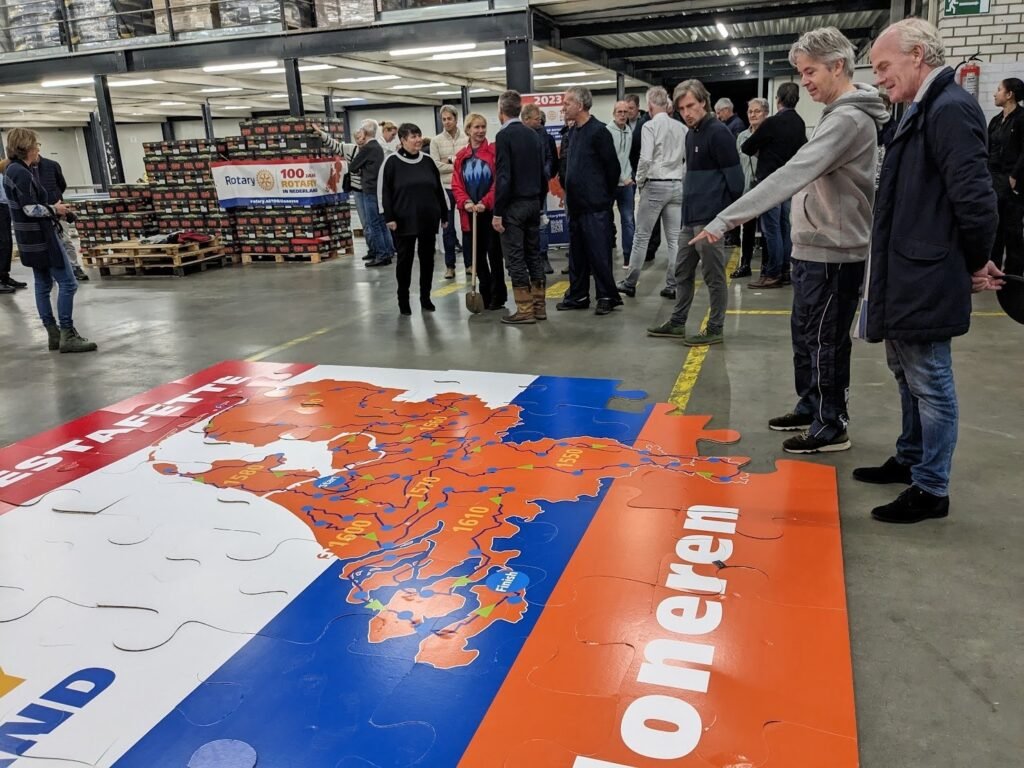
Erik shared this great puzzle map.
“100 years of #RotaryInternational in the Netherlands celebrated with a biking marathon for charity through the country. Today”
MapsintheWild Floor Puzzle Map
-
sur The 2024 Cicadapocalypse
Publié: 17 April 2024, 9:21am CEST par Keir Clarke
2024 is set to see the emergence of two large periodical cicada broods. Both Brood XIX (13-year cicada) and Brood XIII (17-year cicada), are expected to emerge together in 2024 for the first time since 1803. This double emergence has been nicknamed a "cicada-geddon" by some.Periodical cicadas are native to eastern North America. They spend most of their lives underground as nymphs, feeding
-
sur Mappery: Peaks Island Cooler
Publié: 16 April 2024, 11:00am CEST

Doug shared this “Map of Peaks Island keeping my hands warm and my beer cool.”
MapsintheWild Peaks Island Cooler
-
sur Backdrop - the Ultimate Challenge
Publié: 16 April 2024, 6:30am CEST par Keir Clarke
Backdrop Backdrop is a map based game which is somewhat similar to the very popular GeoGuessr game. However in Backdrop instead of Google Maps Street View images you have to identify the locations depicted in famous paintings by some of history's greatest artists.In GeoGuessr you can stroll around in Street View to pick-up clues as to the location that you have been dropped in. In Backdrop if -
sur Spikkin Scots
Publié: 16 April 2024, 2:00am CEST par Keir Clarke
The Shetland Dialect map allows you to listen to examples of the Shetland Dialect spoken across the Shetland Isles. The Shetland Isles are the northernmost region of the United Kingdom, Shetland, positioned between Orkney, the Faroe Islands, and Norway. Due to the isolated geography of the Shetland Isles the Shetland dialect (also called Shetlandic or auld Shetland) has continued to
-
sur Paul Ramsey: Cancer 3
Publié: 16 April 2024, 2:00am CEST
A common refrain on my Facebook cancer support groups is that the first months after diagnosis can be among the most stressful. You know the least about the actual extent of your condition, but you simultaneously know for sure that your life is going to change a great deal, starting now.
It is also the first time for grieving.
In the worst case it is grieving actual mortality, the very real threat of the end. But even in a relatively low impact diagnosis like my (current) one, there is grief. It is the grief of lost futures, lost plans, lost self-image.
I am a person who runs and climbs and rows and goes on long walks and travels and teaches and speaks publicly. At least, I was. If all goes according to plan, there will eventually be a new me, who does some or many of those things. Maybe not all of them anymore, there is no predictability or control.

Last Christmas I took my family to Rome over the holidays. “No time like the present!” I said, little knowing how apt that would be. I’m glad for everything I have done with my family. Climbing mountains, scaling cliffs, travelling afar, and even the predictable summer trips to the beach.
Some of these adventures were quite hard, and in the moment I wondered to myself “what the heck were you thinking?” In the end, I regretted none of it, and we all have lifelong memories we share.
Before she was killed by cancer, Amy Ettinger wrote:
I’ve always tried to say yes to the voice that tells me I should go out and do something now, even when that decision seems wildly impractical … Money always comes back, but if you miss out on an experience, the opportunity may never come back.
I am trying to pack as much climbing, and eating out, and walks to the cafe, and evening date nights into my life as I can, before the start of treatment. It’s too late for anything big, but these are little things that bring me joy that may become harder to do, after.
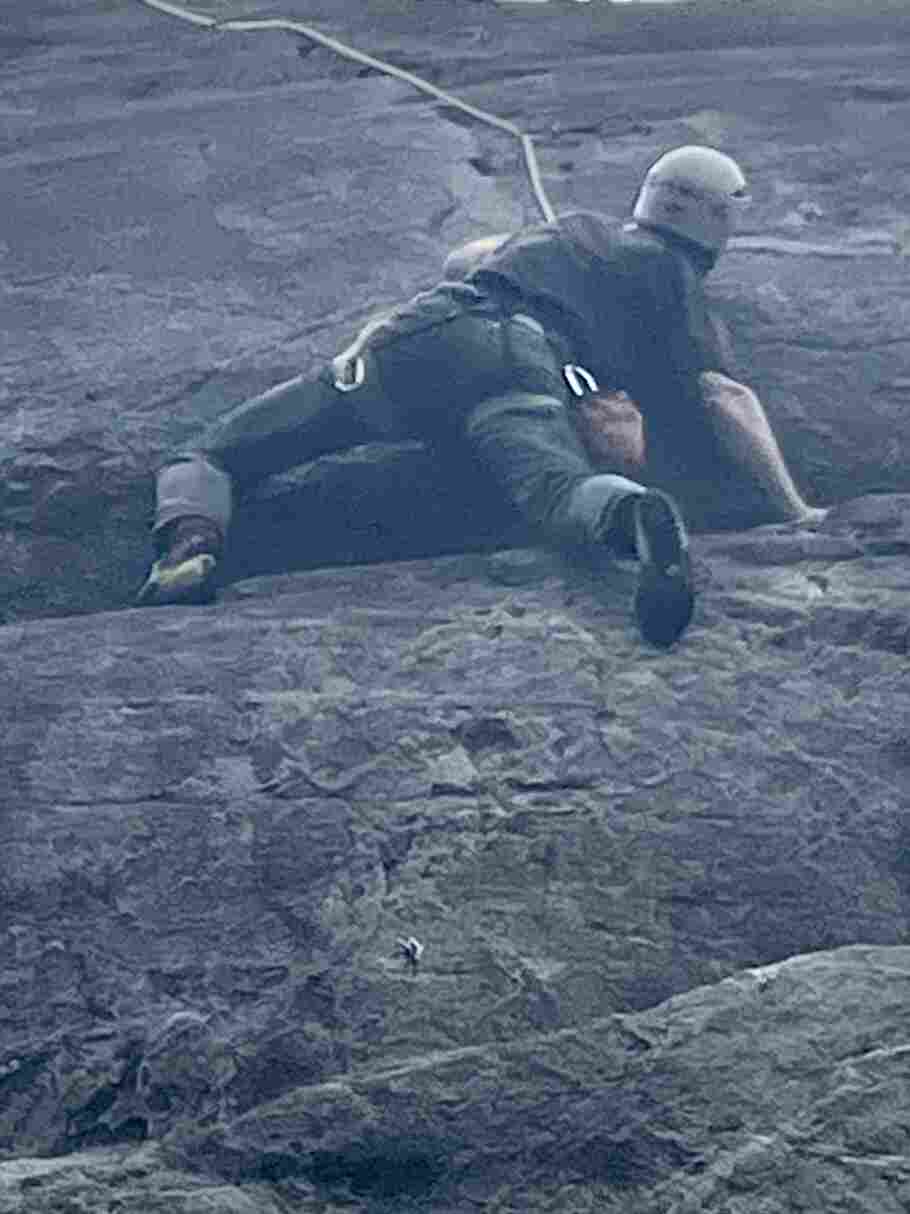
My surgery date is set now, and the procedure will mark an abrupt decline and then the start of a long slow climb back up to whatever “new normal” my body can fashion from my reconfigured plumbing. Some people have great results, some people have terrible ones.
As always, there’s no way to know, the grey area is omnipresent, which is perhaps why I sound so morose.
Talk to you again soon, inshalla.
-
sur Sean Gillies: Bear training weeks 1-8
Publié: 15 April 2024, 11:28pm CEST
The first quarter of my season has been challenging. I've had to deal with injuries and other niggles, and I'm just starting to feel better when I run. Moving forward on fitness while not being able to run very much has been an interesting problem to work on.
As I mentioned in Preason running I started my 8 week block of interval workouts with nagging knee pain. This pain continued for 6 weeks. I dealt with it by alternating outdoor runs with low-impact sessions on an elliptical or stair-stepper machine. I did one outdoor session of hill intervals and one indoor session of stair-stepper intervals every week. By the end of the block, I was doing 36 minutes of hard uphill running, and 4 hours of easier running or stepping in a week. It's not where I want to be. At least I didn't have to skimp on the hard intervals. I'm satisfied with doing as much hard running as my knee allowed, and enjoy feeling more fit.
At the end of last year, I was determined to get some physical therapy and rehabilitate my ankles and feet. I've been visiting a local clinic once a month and have been diligent about doing the recommended exercises. The therapist says that I have good range of motion in my ankles, though there is an imbalance; my right ankle has excellent mobility while the left is only better than average. My bigger problem, in the therapist's view, was that my toes and feet are weak. I needed to build muscle so that I can do toe stands easily and lift my arches. So, I've been going to the gym to build muscle three times a week. I do sets of back squats (5 x 5) for overall strength, and then do sets (3 x 10) of single-leg calf raises on a step with a kettlebell, single-leg squats with toe taps using a barbell and band around my thighs, and single-leg deadlifts with dumbbells. The Three Amigos, as I've been calling these single-leg exercises, have been working for me. My feet and lower legs are stronger and their imbalances are getting ironed out. I feel almost equally good with the deadlifts now, wobbling just one time out of ten, at most, on my left leg. The therapist has me progressing to single-leg jumping now, and I'm feeling better balance with the new exercises, too.
Consistent strength training, conservative running, and changing the way I sit at work seem to have let my knee recover. I'm standing, sitting on a stool, and reclining more when I work, using a conventional office chair less, and at maximum height when I do.
A radiology visit in December revealed that I'm developing a bone spur on my right heel. I wonder if this is yet another symptom of imbalance in my feet and legs, more stress on my right foot caused by favoring my weaker left? I'm getting some consultation on this and meanwhile am icing regularly. Two weeks ago I had to stop running for 3 days to treat aggravation of my right sciatic nerve. It was a good reminder to be more diligent about stretching and foam rolling. Otherwise, I'm doing pretty well. Heart palpitations are behind me. I'm eating and sleeping well, keeping sinus infections at bay, and enjoying longer days and generally nice spring weather.
I'm grateful to be able to continue training and am looking forward to a productive block of tempo running.
-
sur Mappery: Can you guess where this fingerpost is?
Publié: 15 April 2024, 12:00pm CEST

Harel Dan shared this pic with me. Can you guess where it is? Scroll down to find out.


Harel explained “The uniquely American passion for copying other placenames from every corner of the world, led to there being all these places within a few hundred miles of each other in the state of Maine. Someone was clever enough to make a tourist trap out of it.”
MapsintheWild Can you guess where this fingerpost is?
-
sur GeoGuessr for Art
Publié: 15 April 2024, 8:09am CEST par Keir Clarke
Calling all art sleuths and geography buffs! There's a new game in town that will test your knowledge of both the artistic and the actual world. Buckle up, because Backdrop is here to take you on a virtual journey through the works of the world's most famous artists.Inspired by the wildly popular GeoGuessr, Backdrop throws you into the heart of stunning landscapes and iconic cityscapes, all
-
sur Mappery: Compass Coffee
Publié: 14 April 2024, 12:00pm CEST
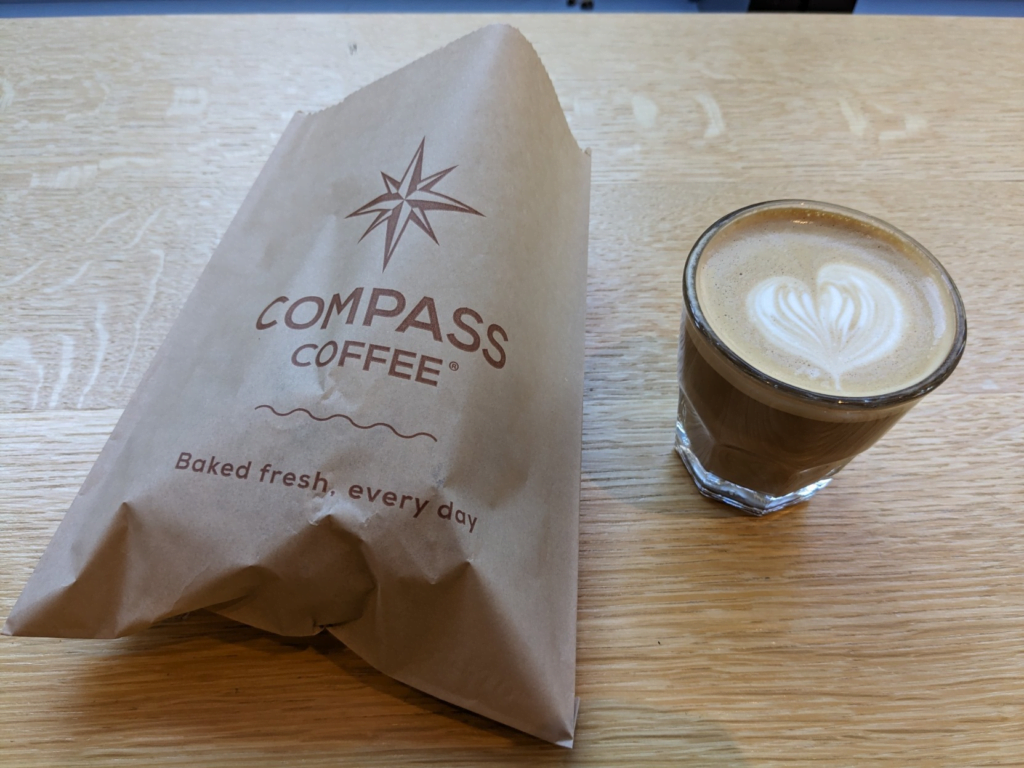
Another one from Erik’s US trip
I know that some will complain about the cardinal points not being a map but we have had them before and if you want to go ultra geek you could probably visualise a country outline in a weird projection in the coffee.
MapsintheWild Compass Coffee
-
sur Paul Ramsey: Cancer 2
Publié: 14 April 2024, 2:00am CEST
Before I joined the population of fellow cancer travellers, I had the same simple linear understanding of the “process” that most people do.
You get diagnosed, you get treatment, it works or it doesn’t.
What I didn’t appreciate (and this will vary from cancer to cancer, but my experience is with colorectal) is how little certainty there is, and how wide the grey areas are.
Like, in my previous post, I said I was “diagnosed” with cancer. Which maybe made you think I have it. But that’s not how it works. I had a colonoscopy, and a large polyp was removed, and that polyp was cancerous, and a very small part of it could not be excised. So it’s still in me.
Do I have cancer? Maybe! I have a probability of having live cancer cells in me that is significantly higher than zero. But not as high as one.

How bad is what I have? This is also a game of probabilty. Modern technology can shave off the edges of the distribution, but it can’t quite nail it down.
A computed tomography (CT) scan didn’t show any other tumors in my body, so that means I probably don’t have “stage 4” (modulo the resolution of the scan), which is mostly incurable (though it can be manageable), where the cancer has managed to spread outside the colon.
An MRI didn’t show any swollen lymph nodes, which means I maybe do not have “stage 3”, which requires chemotherapy, because the cancer has partially escaped the colon. But MRI results are better at proving rather than disproving nodal involvement and people report having surgical results that run counter to the MRI all the time.
That leaves me (theoretically) at “stage 2”, looking at a surgical “cure” that involves removing the majority of my rectum and a bunch of lymph nodes. At that point (after the major life-altering surgery!) the excised bits are sent to a pathologist, and the probability tree narrows a little more. Either the pathologist finds cancer in the nodes (MRI was wrong), and I am “upstaged” to stage 3 and sent to chemotherapy, or she doesn’t and I remain a stage 2 and move to a program of monitoring.
In an exciting third possibility, the pathologist finds no cancer in the lymph nodes or the rectum, which means I will have had major life-altering surgery to remove… nothing dangerous. My surgeon says I should find this a happy result (no cancer!) which is probably because he’s seen so many unhappy results, but it’s a major surgery with life-long side effects and I would do almost anything to not have to have it.
Amazingly, despite our modern technology there’s just no way to know for sure if there are still live cancer cells in me short of taking the affected bits out and doing the pathology. Or waiting to see if something grows back, which is to flirt with a much worse prognosis.
Monitoring will be regular blood tests, annual scans and colonoscopies for several years, as the probability of recurrence slowly and asymptotically moves toward (but never quite arrives at) zero. And all those tests and procedures have their own error rates and blind spots.
There are no certainties. All the measuring and cutting and chemicals, and I will still have not driven the cancer entirely out, it will stubbornly remain as a probability, a non-zero ghost haunting me every year of the rest of my hopefully long life.
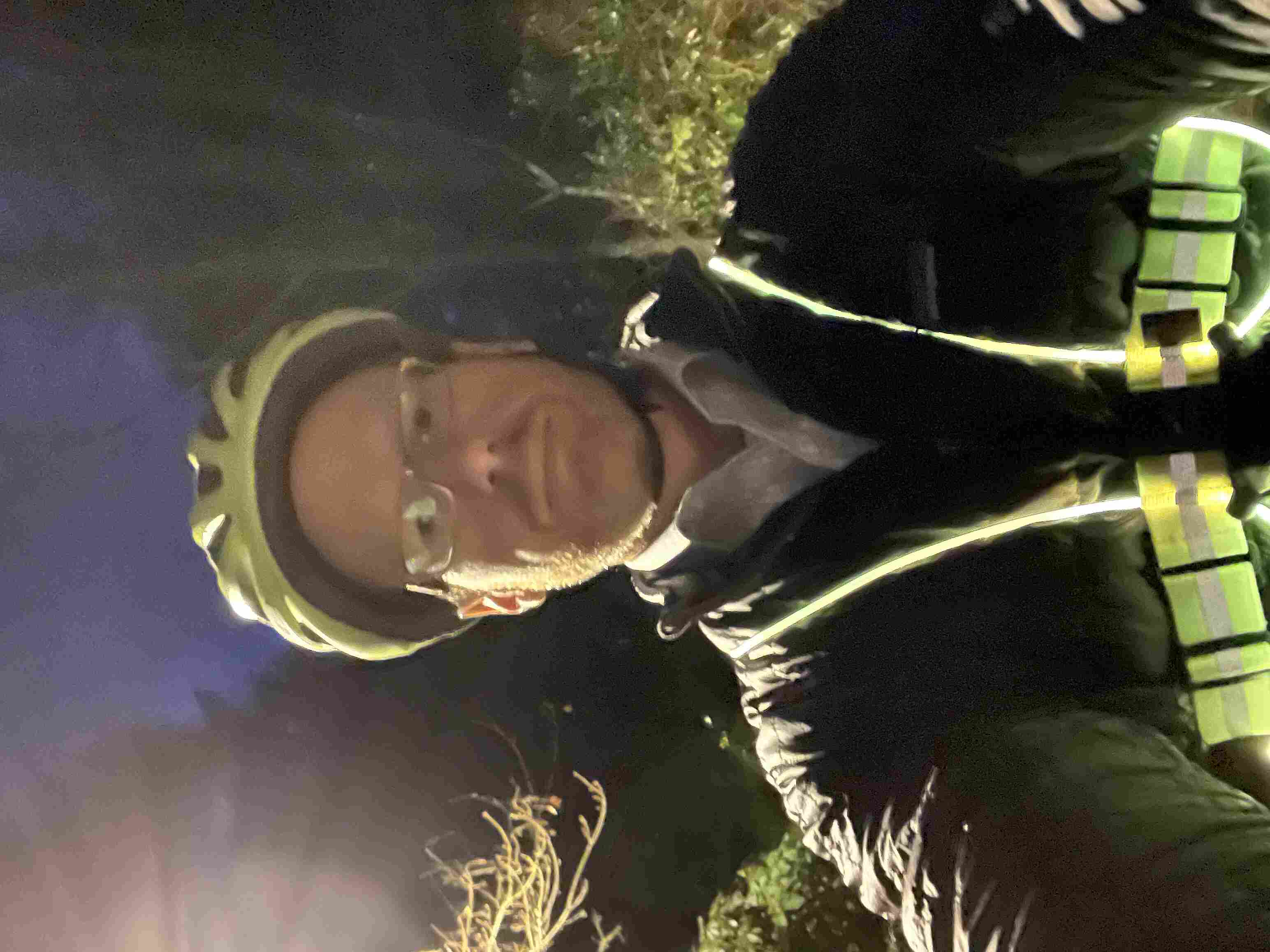
And of course worth mentioning, I am getting the snack-sized, easy-mode version of this experience! People in stage three or stage four face a probability tree with a lot more “and then you probably die in a few years” branches, and the same continuous reevaluation of that tree, with each new procedure and scan, each new discovery of progression or remission.
Talk to you again soon, inshalla.
-
sur Mappery: The Pieces of London
Publié: 13 April 2024, 11:00am CEST

We all love a map jigsaw, well at least Harry Woods and I do. Here’s Harry making a jigsaw map of London that was made from OpenStreetMap.
I guess you could make a jigsaw of your favourite location, could be one for my friends at SplashMaps.
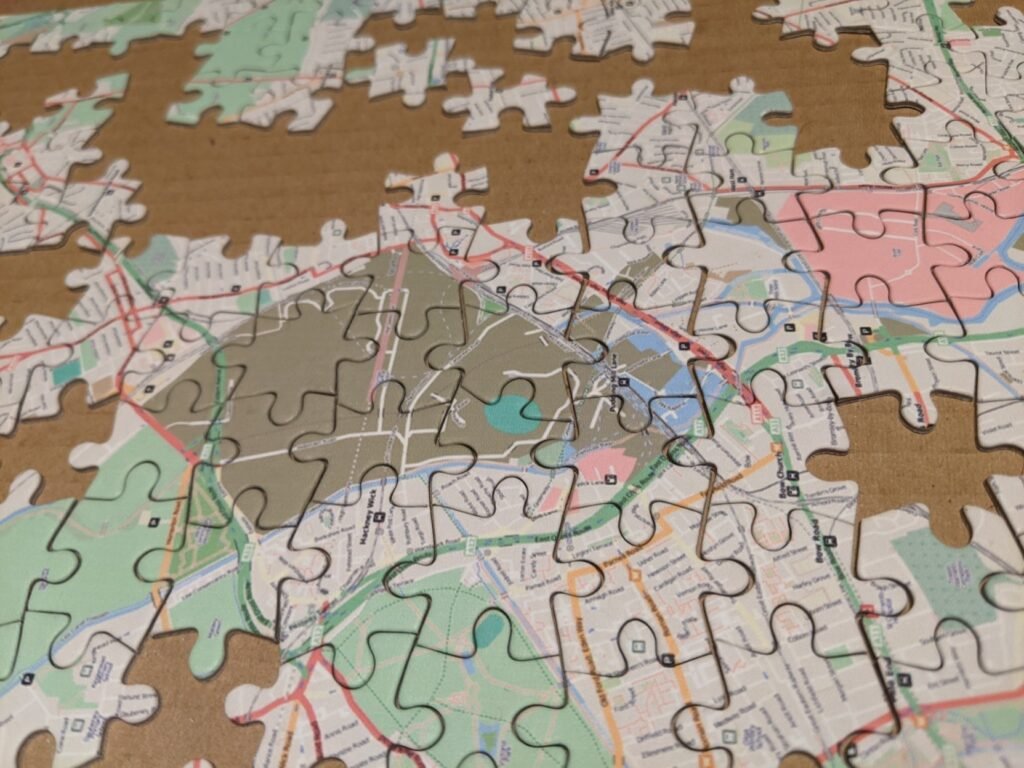

MapsintheWild The Pieces of London
-
sur The AI Music Map
Publié: 13 April 2024, 10:07am CEST par Keir Clarke
Over the last few days my Twitter feed has been lit up by people sharing the songs that they have created on Udio. For the one or two cave dwellers out there who have only just installed spelunking wi-fi, Udio is an AI-powered music generation tool which allows users to create songs from a text prompt. The tool allows you to create tunes with customized lyrics, vocal styles, and musical



